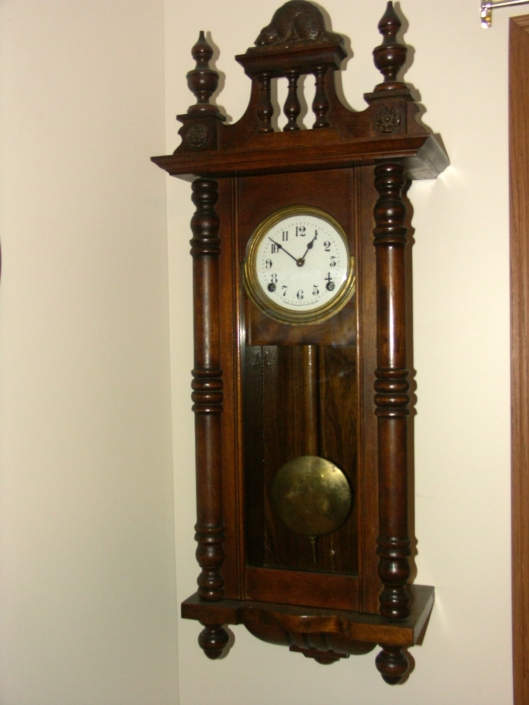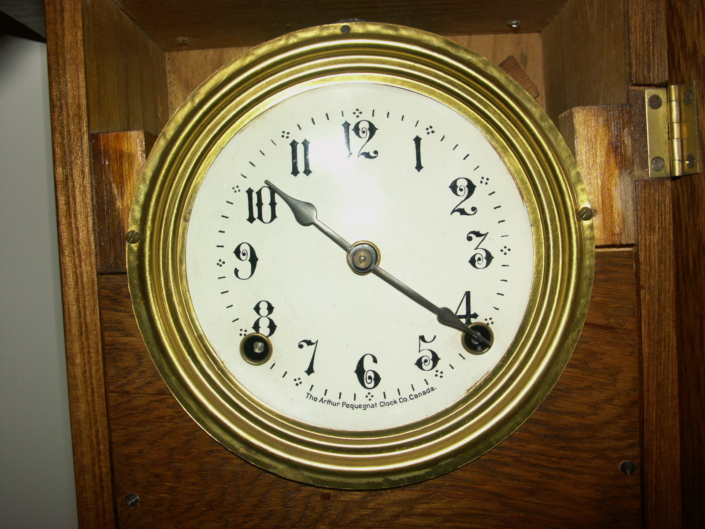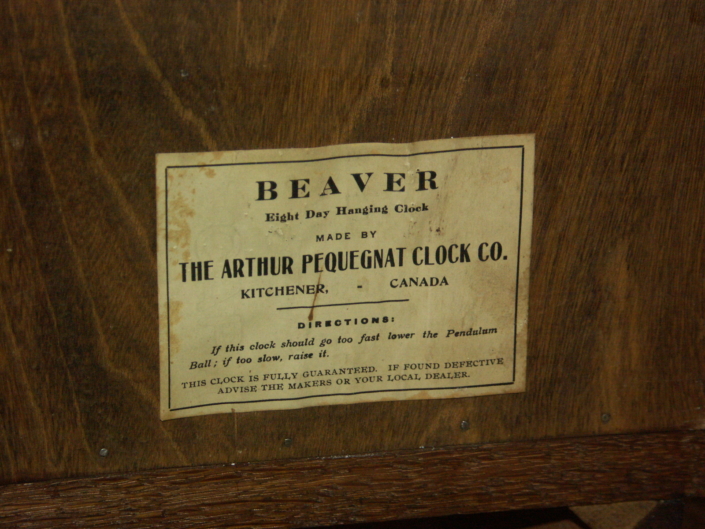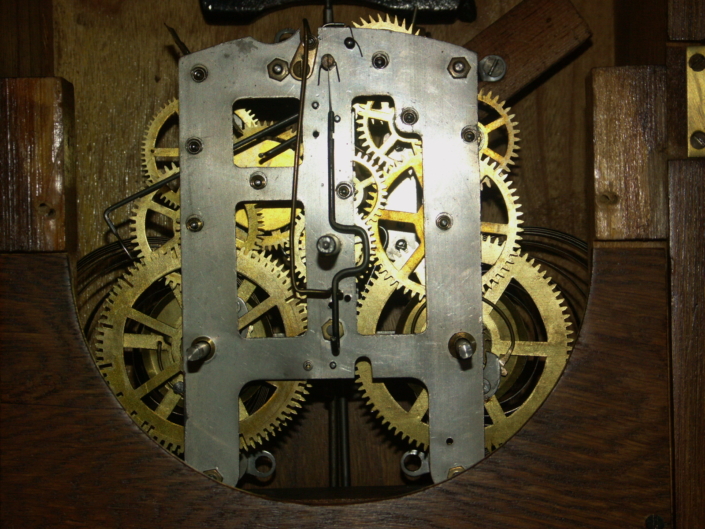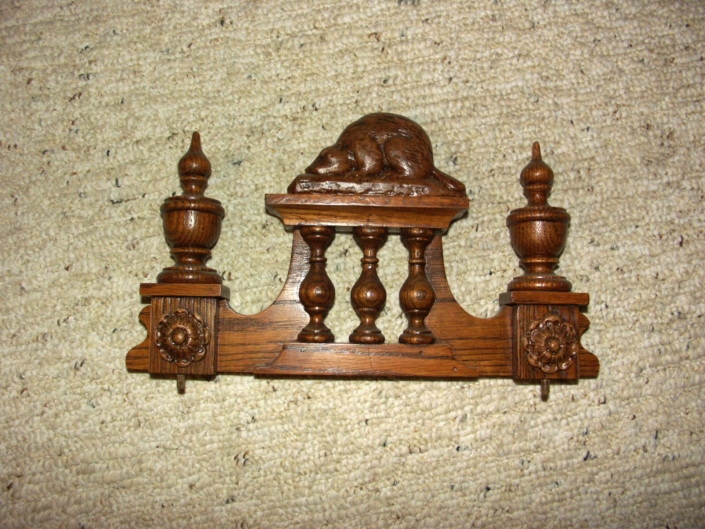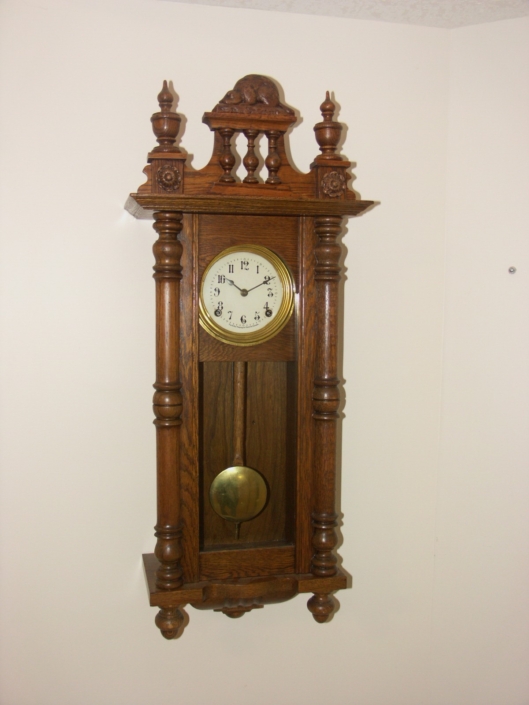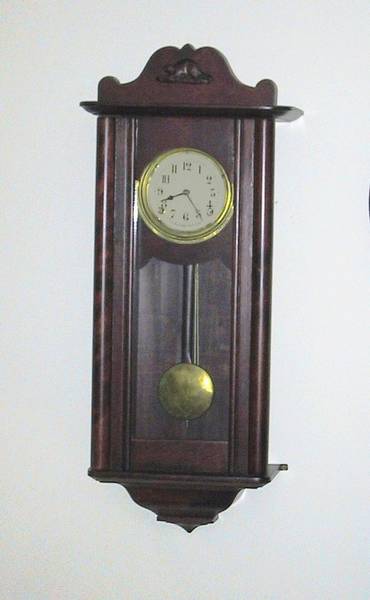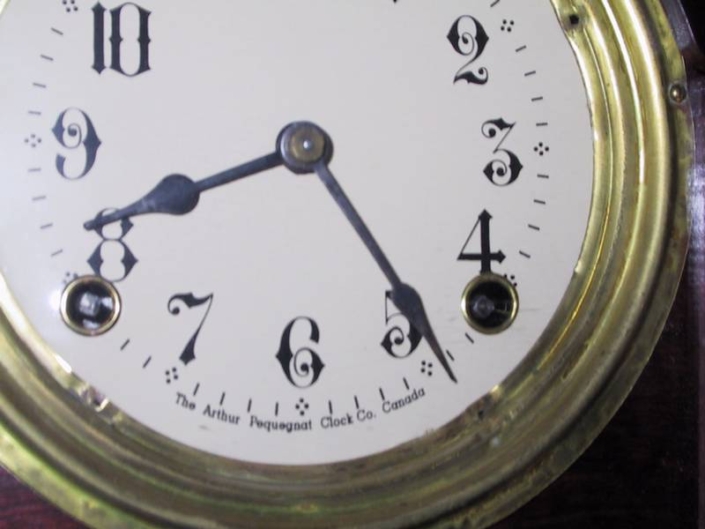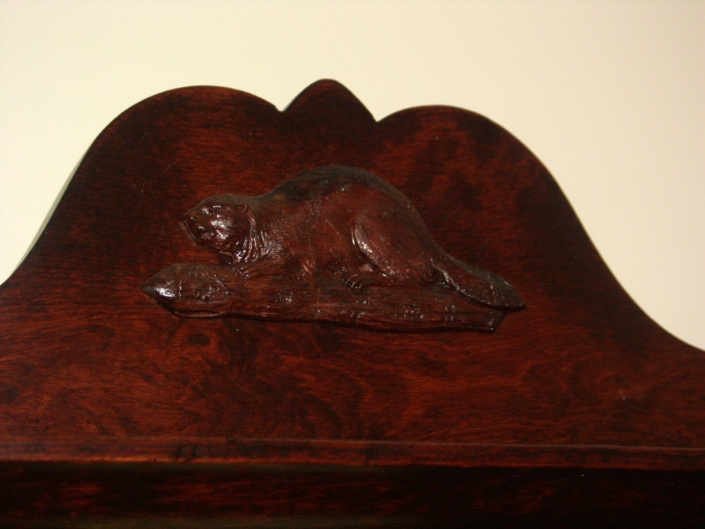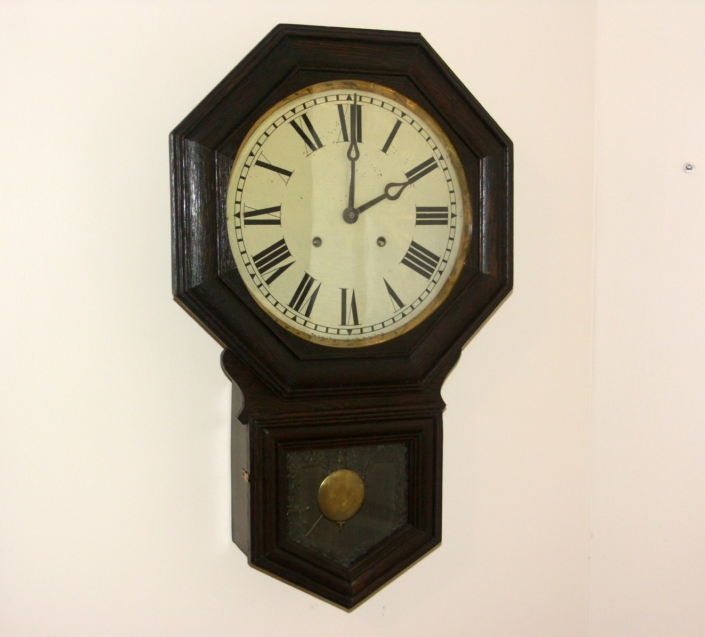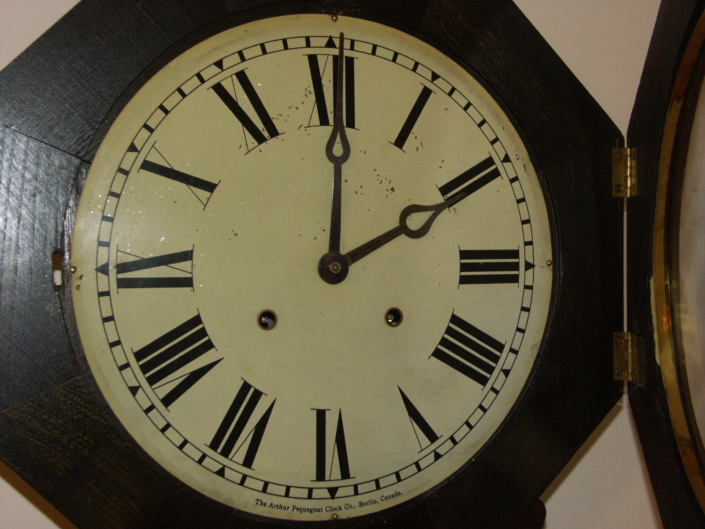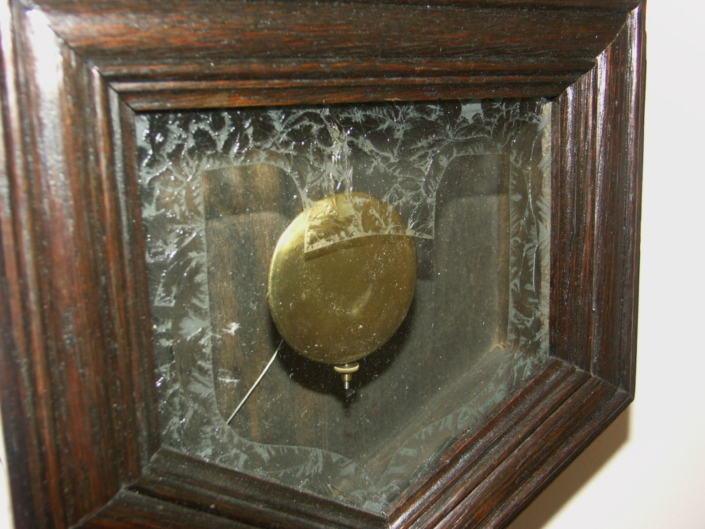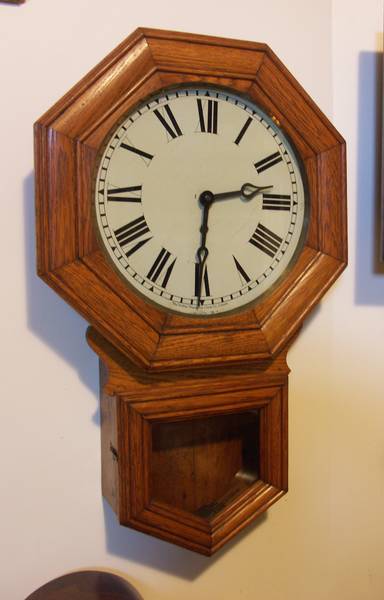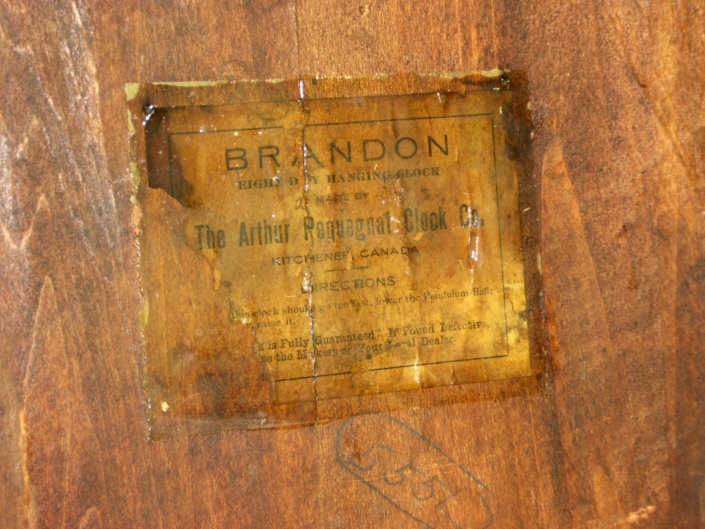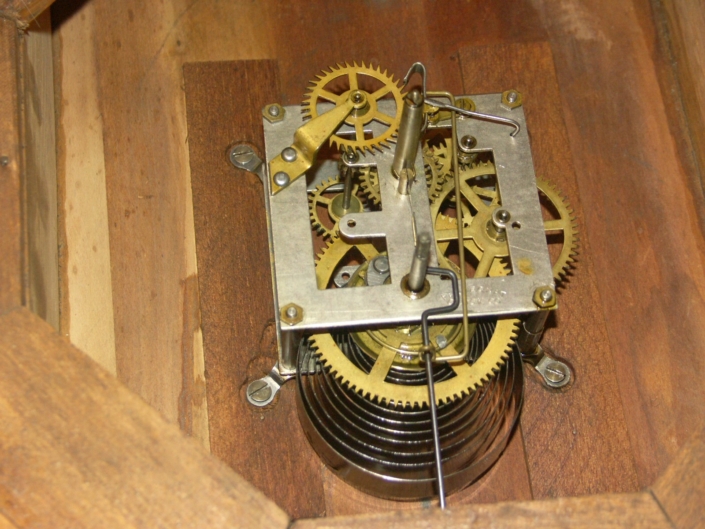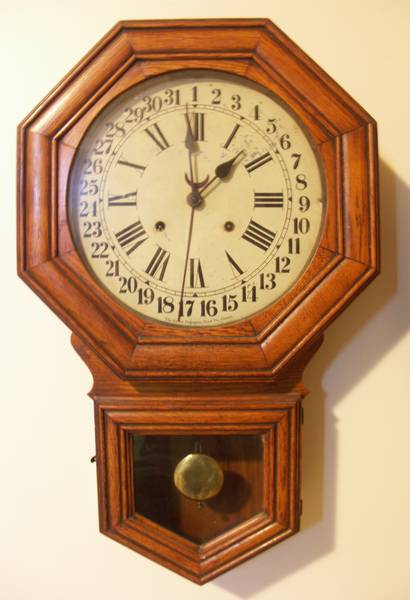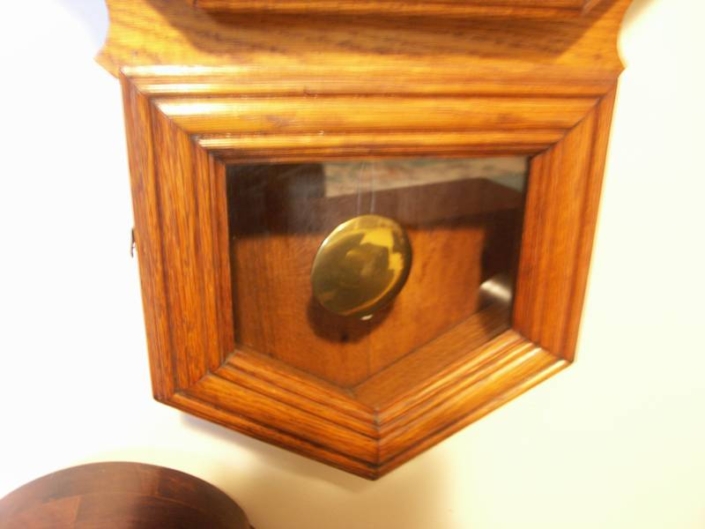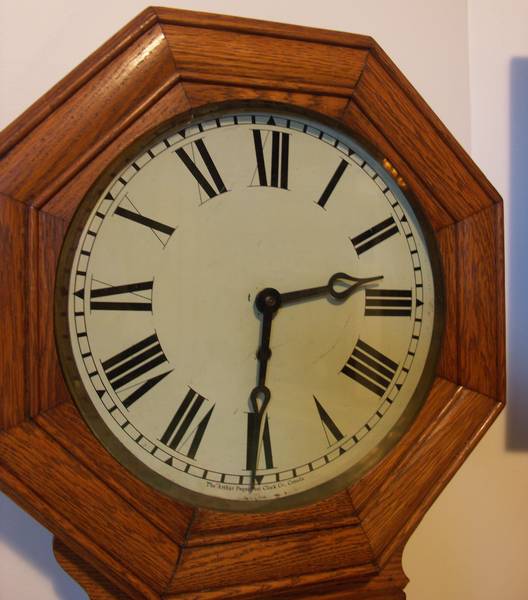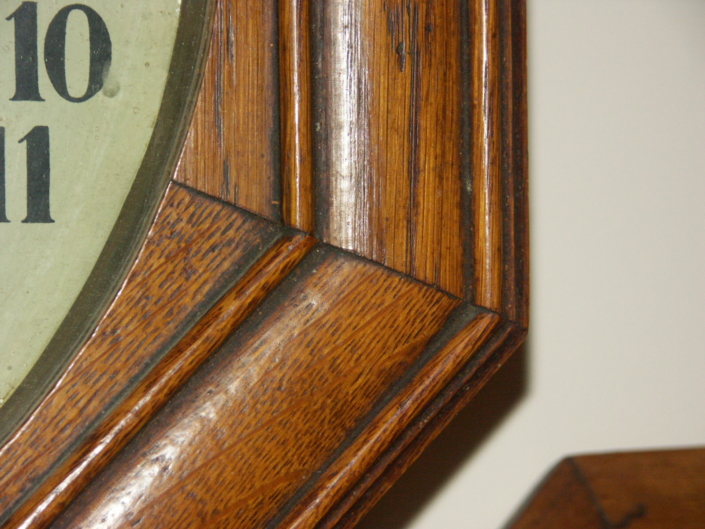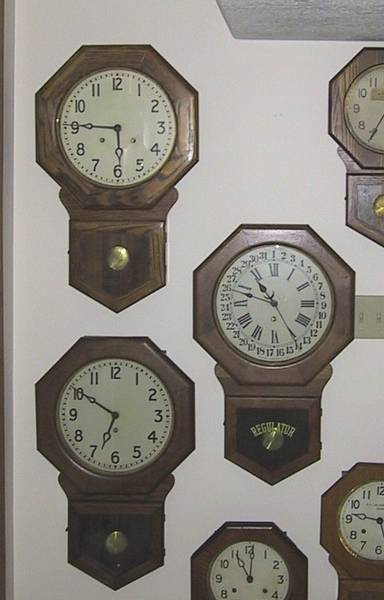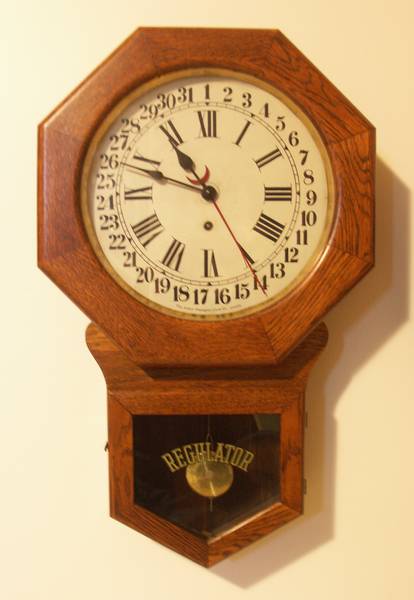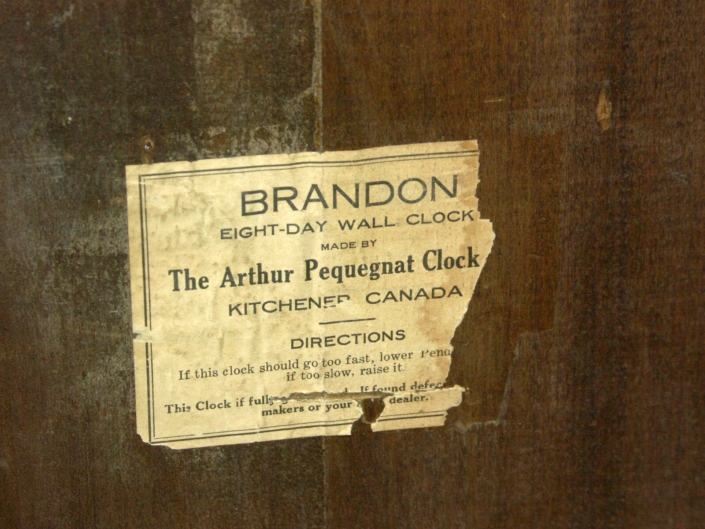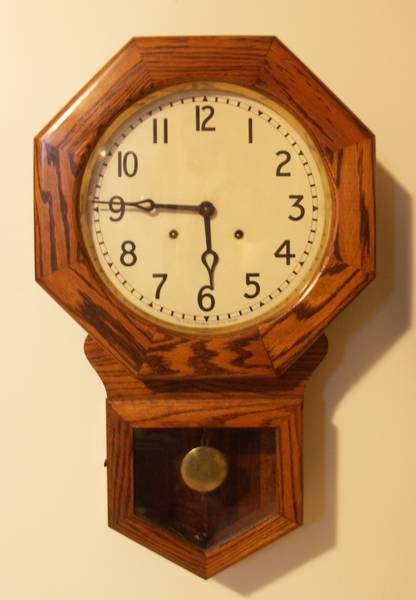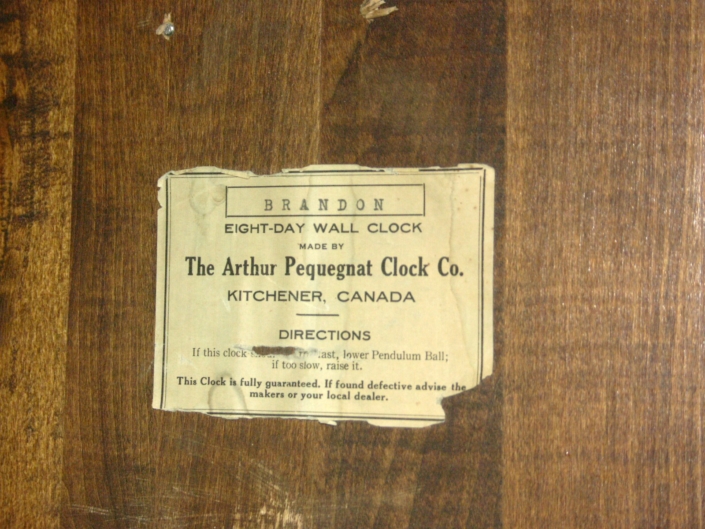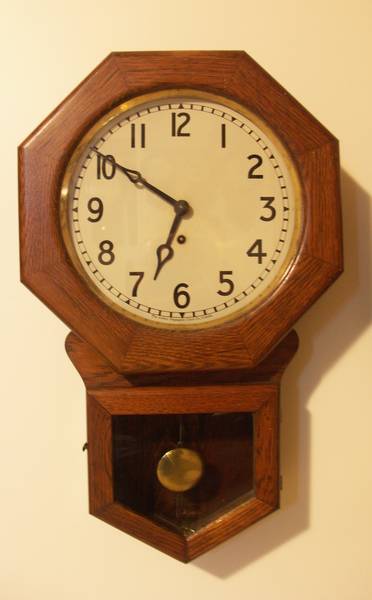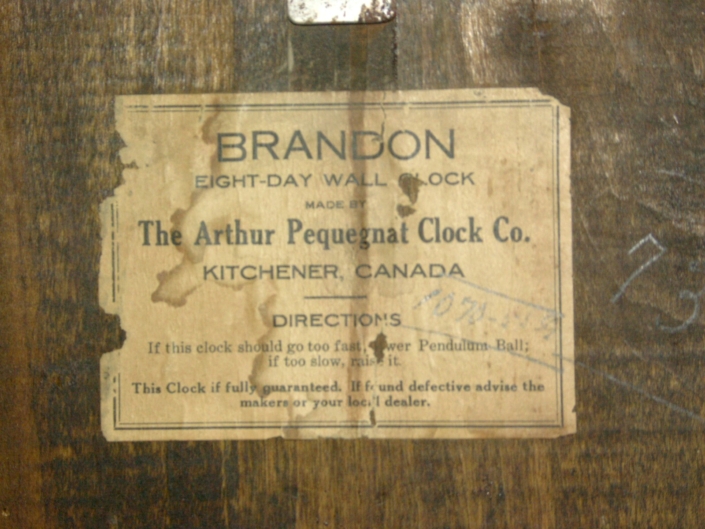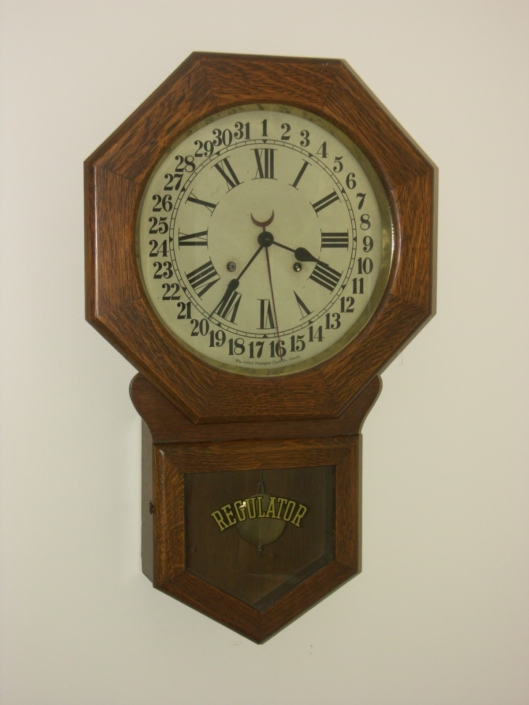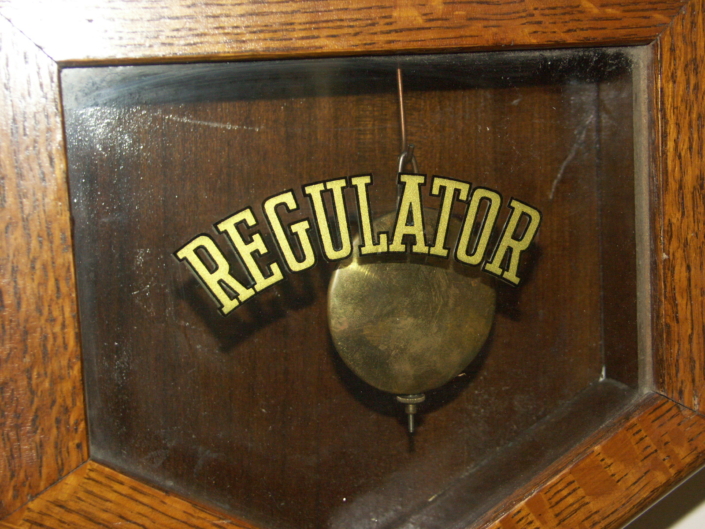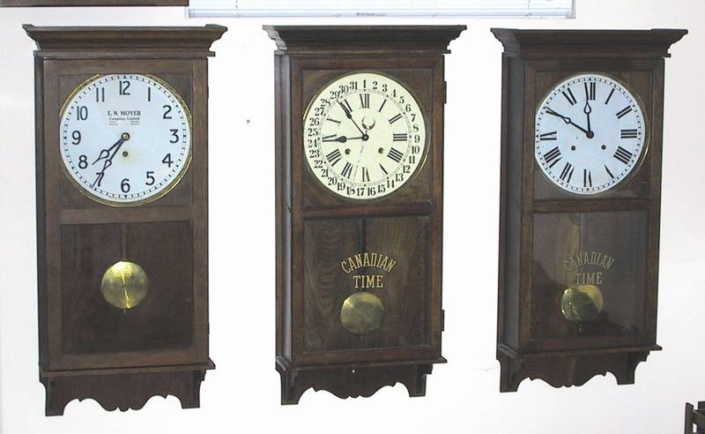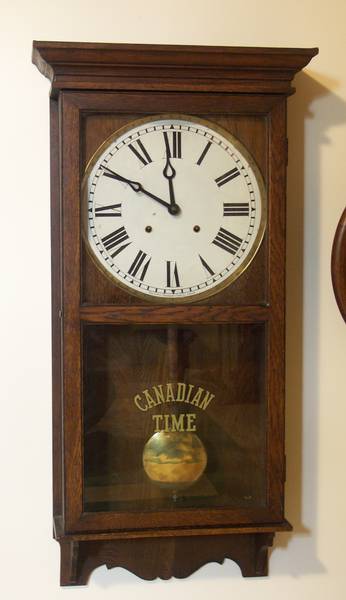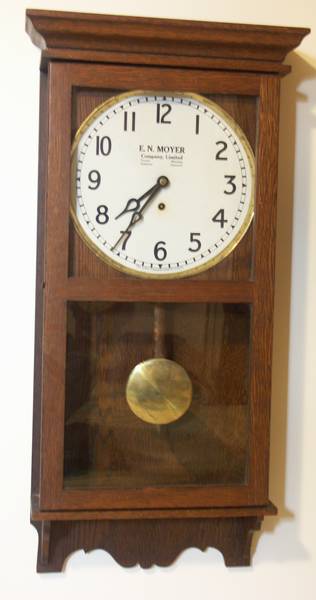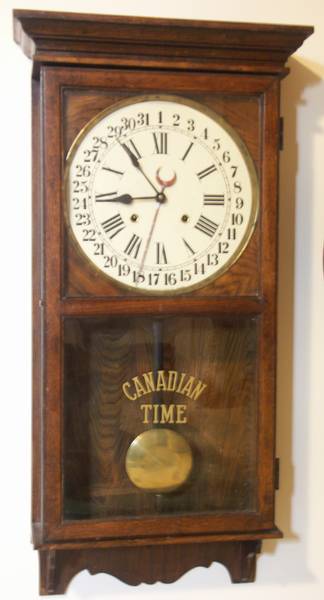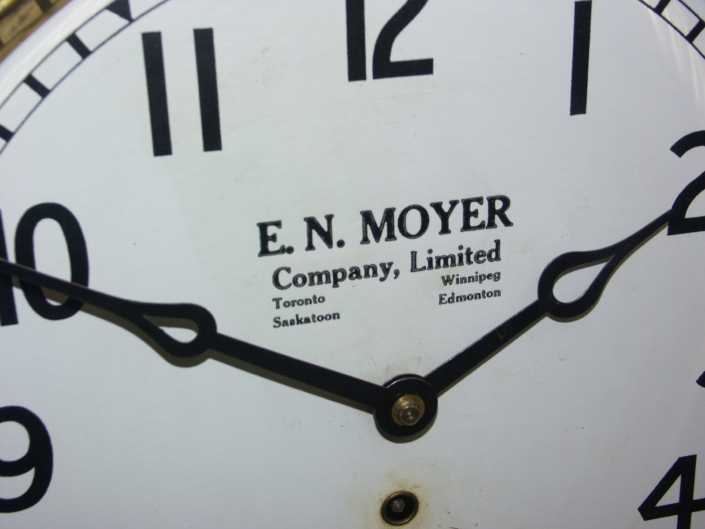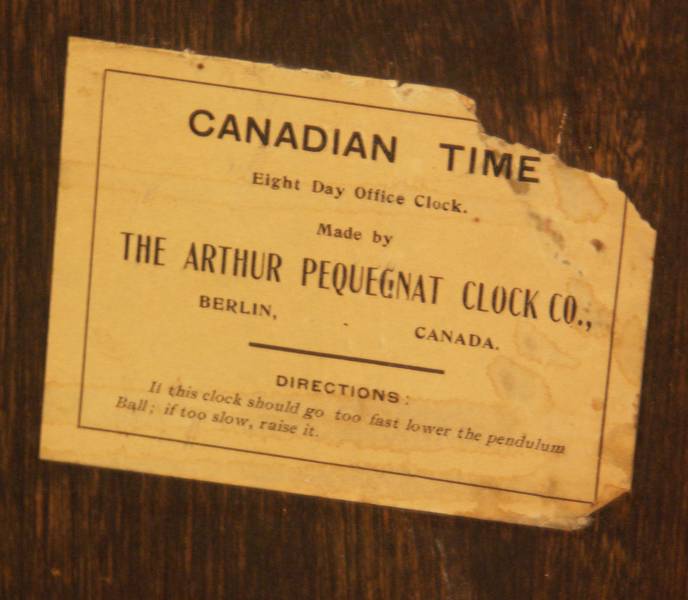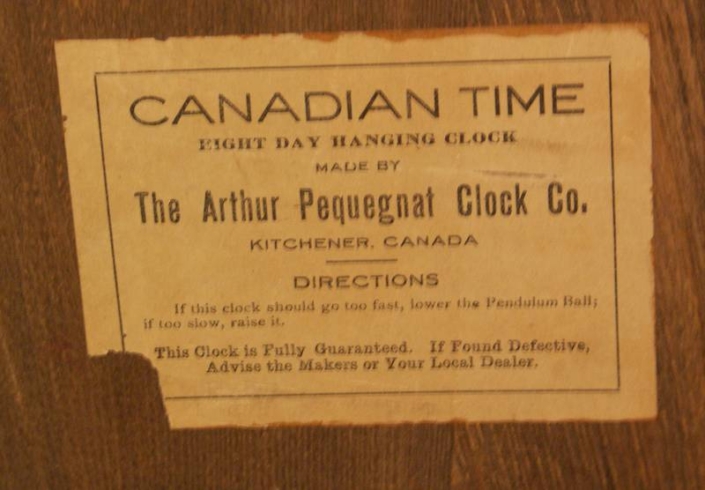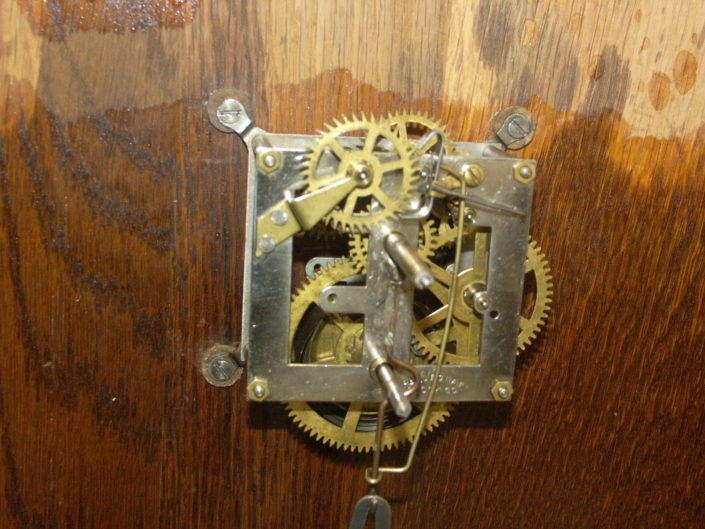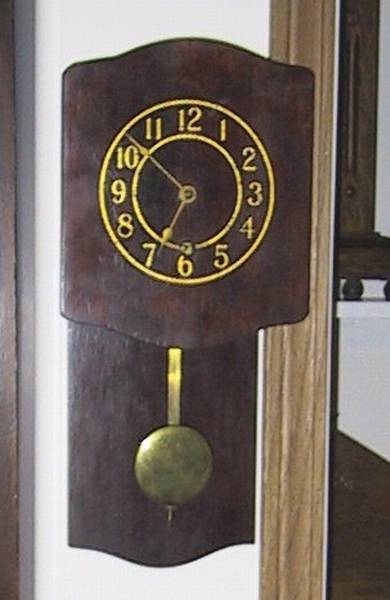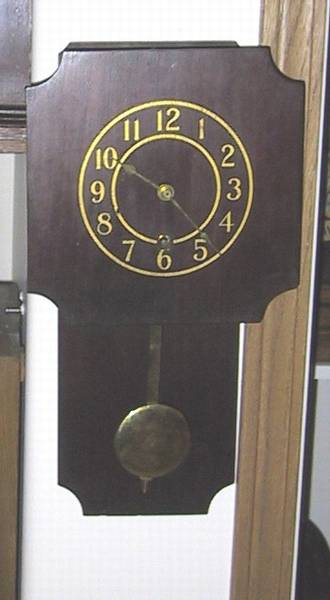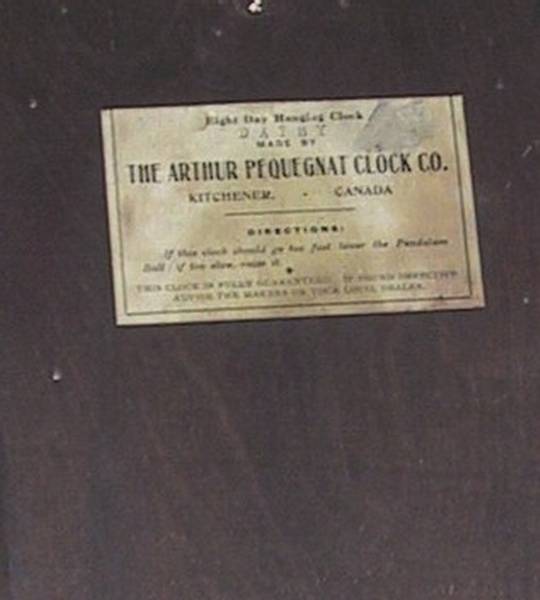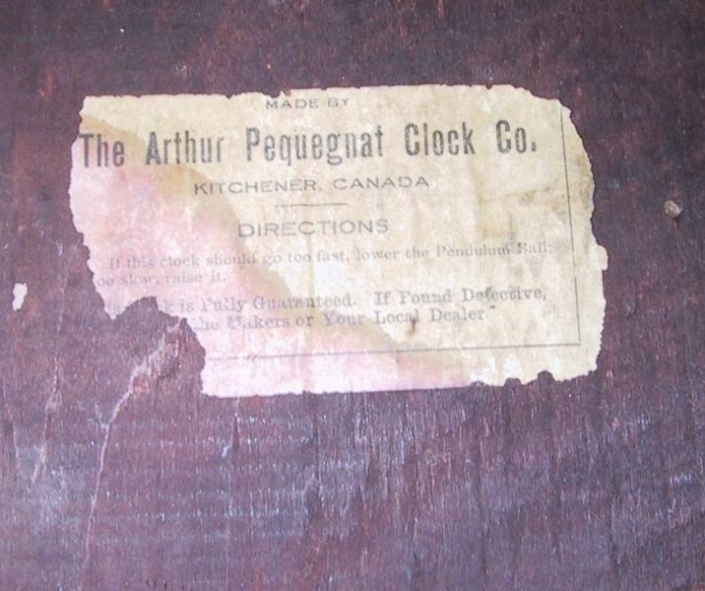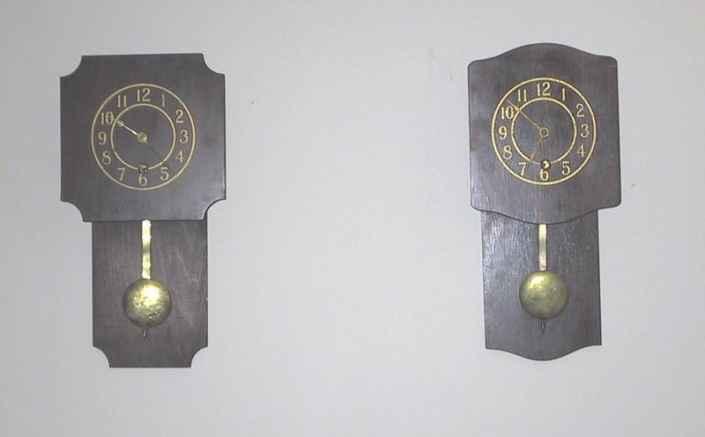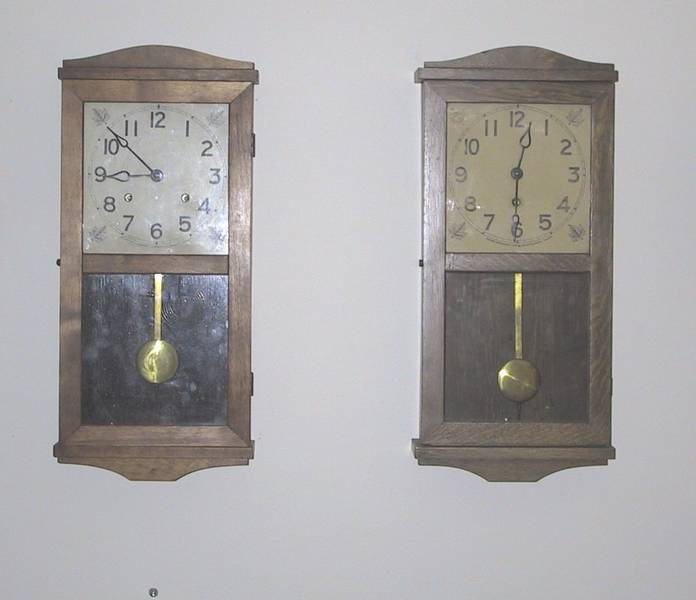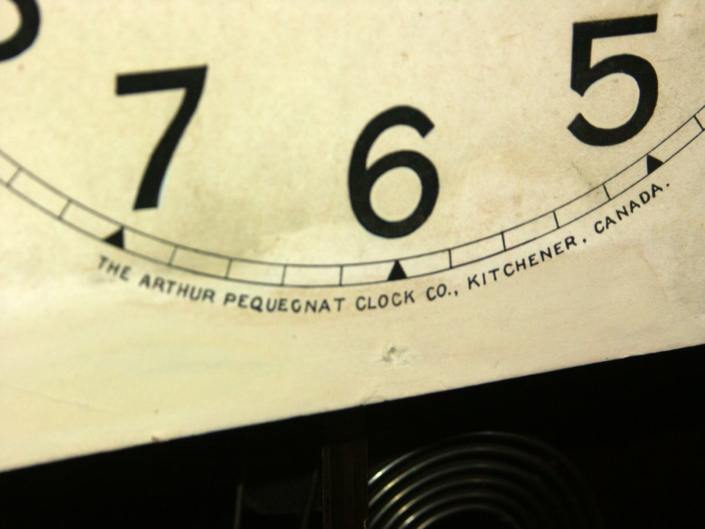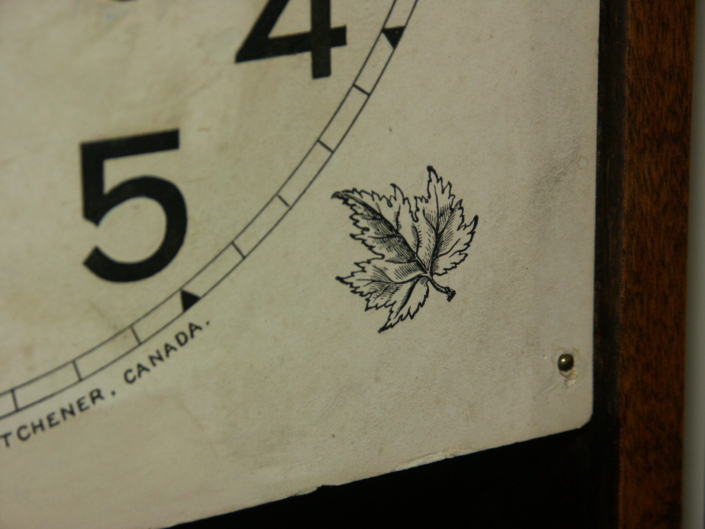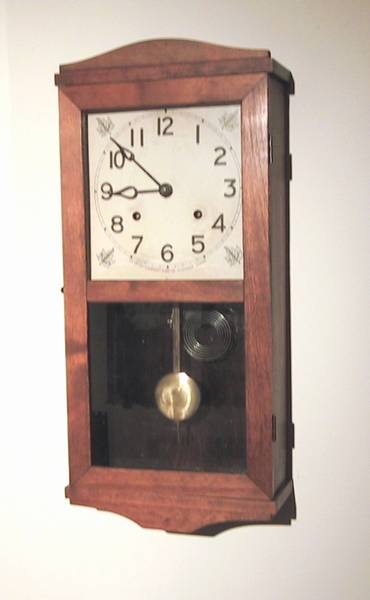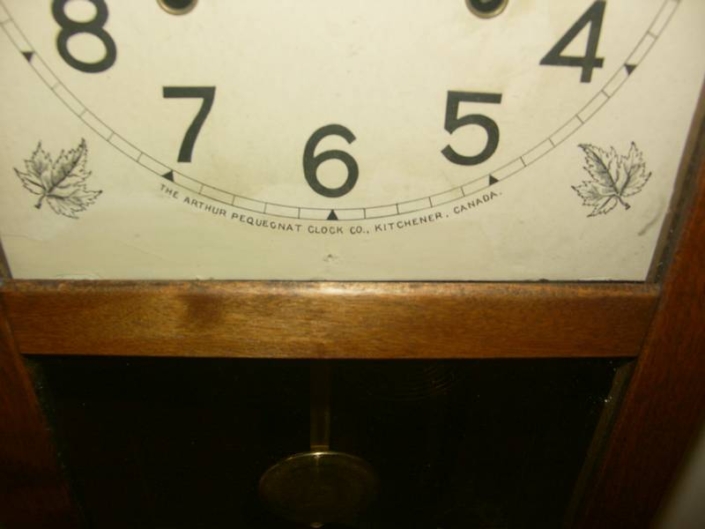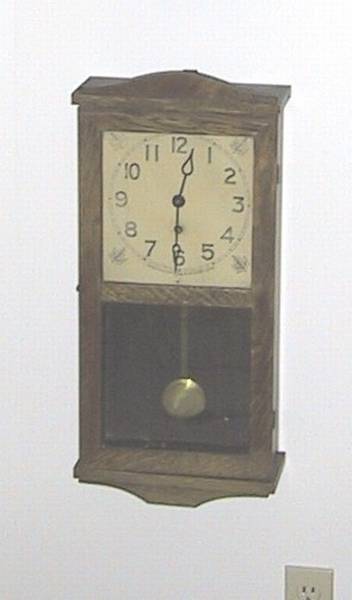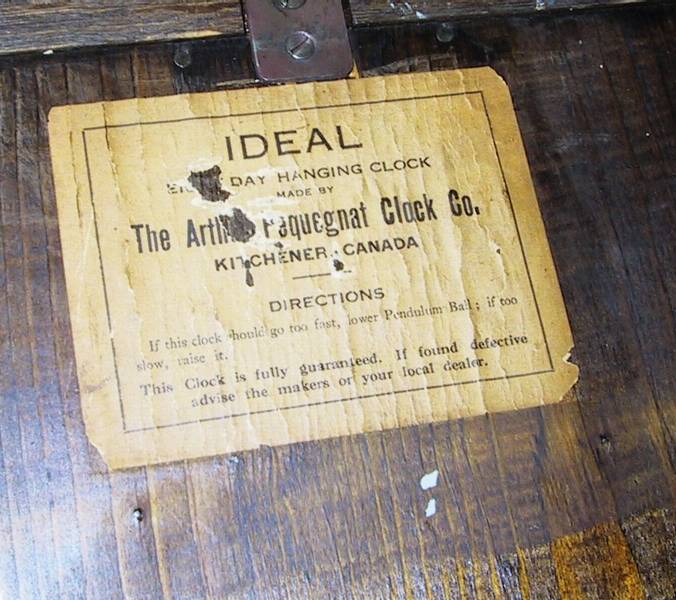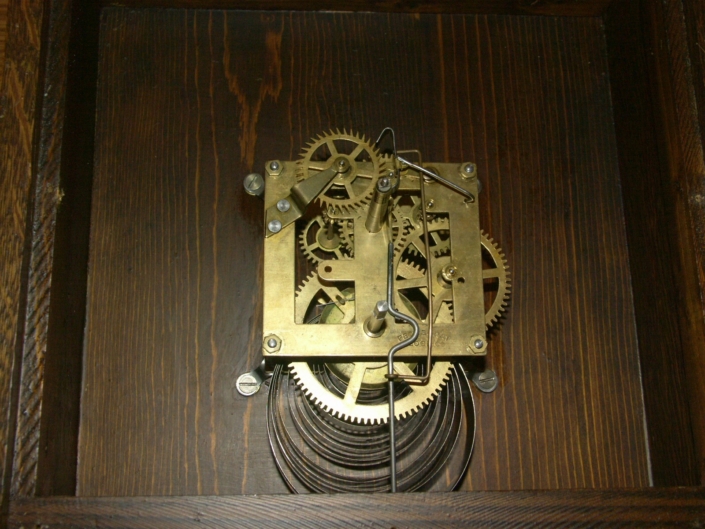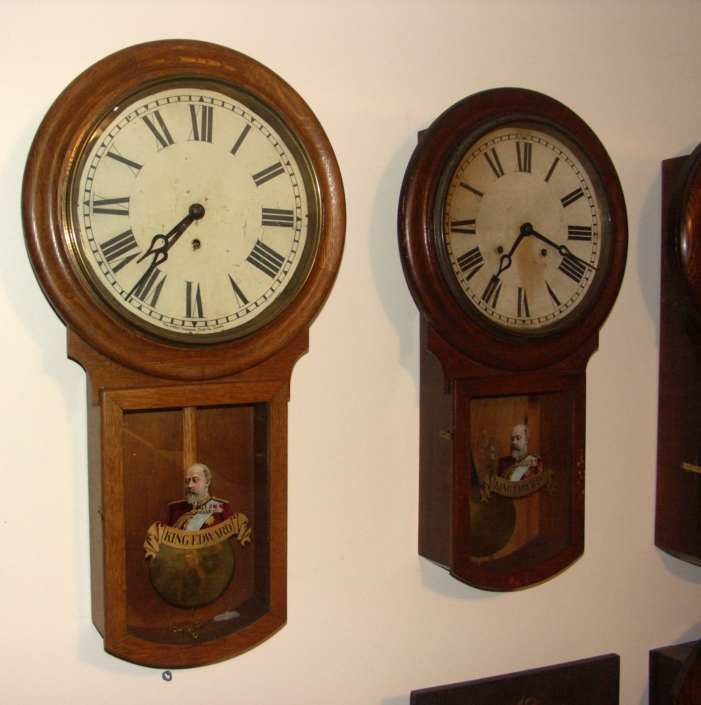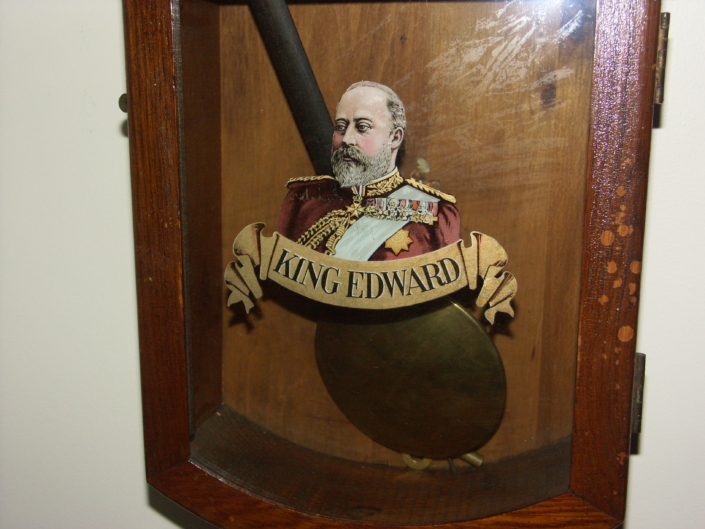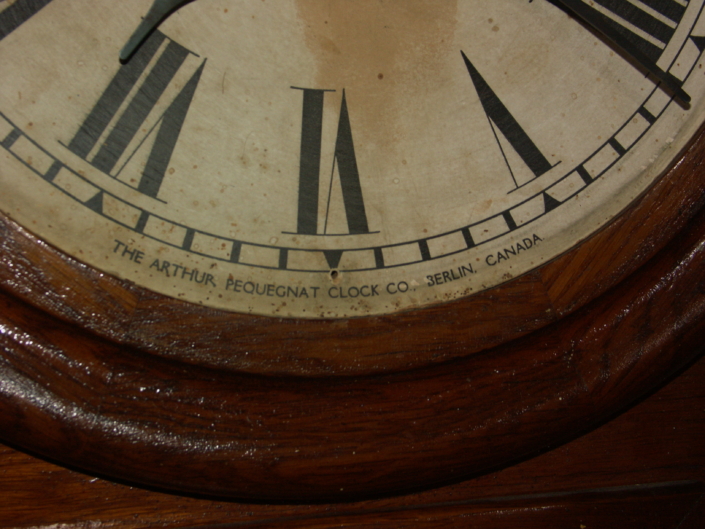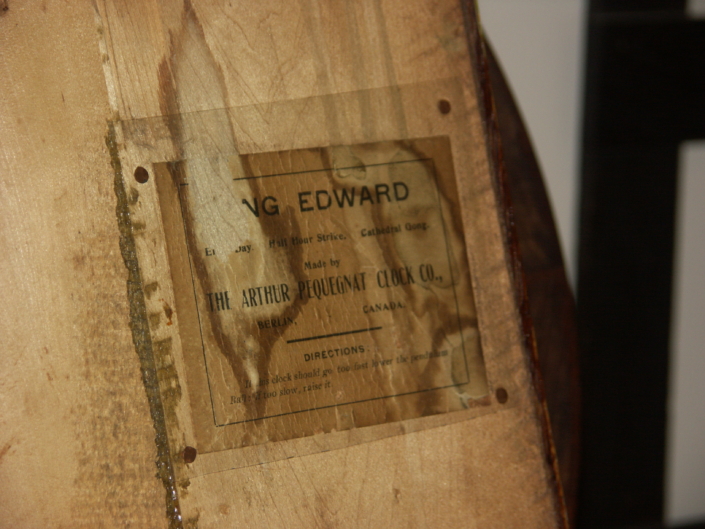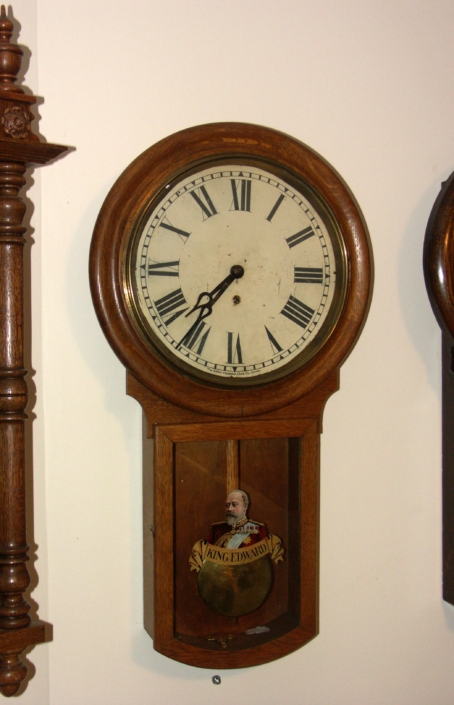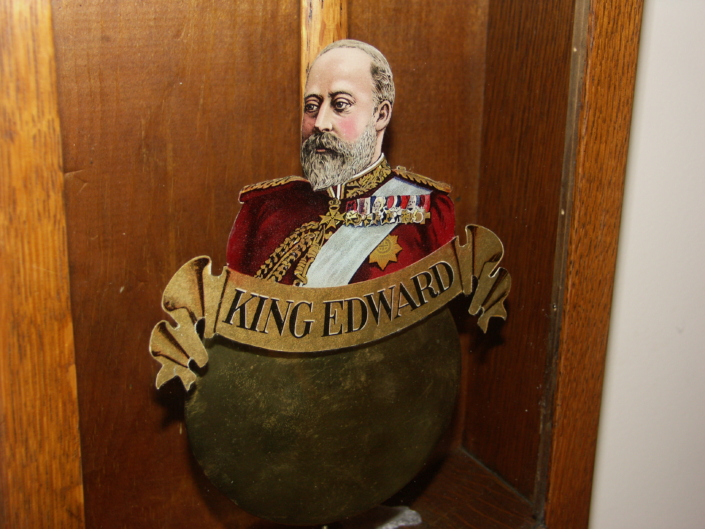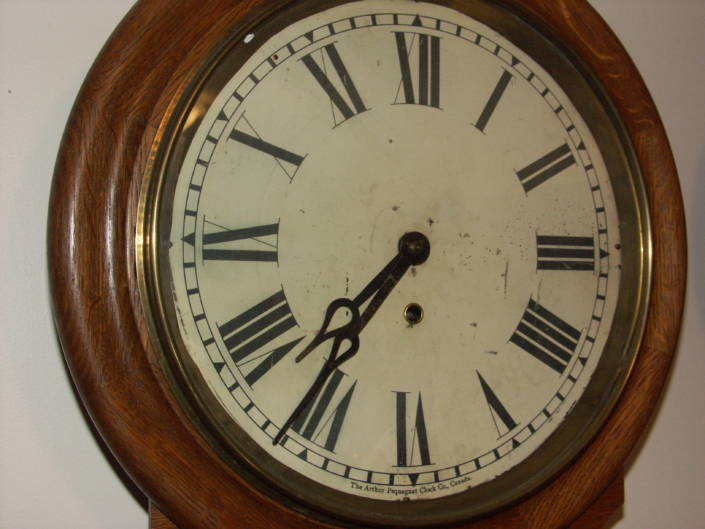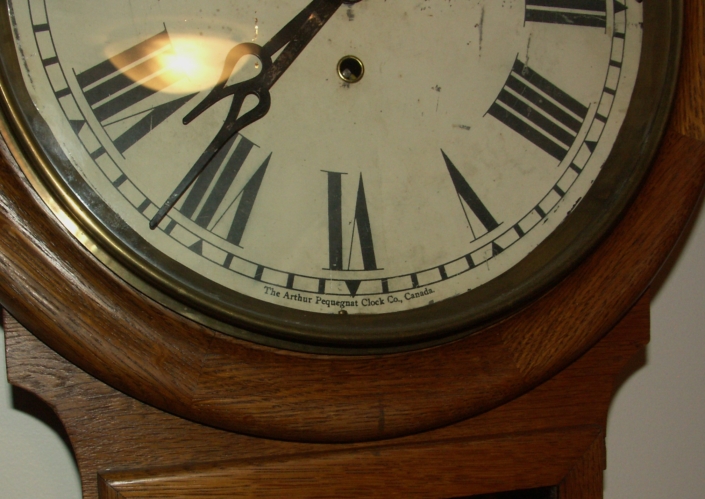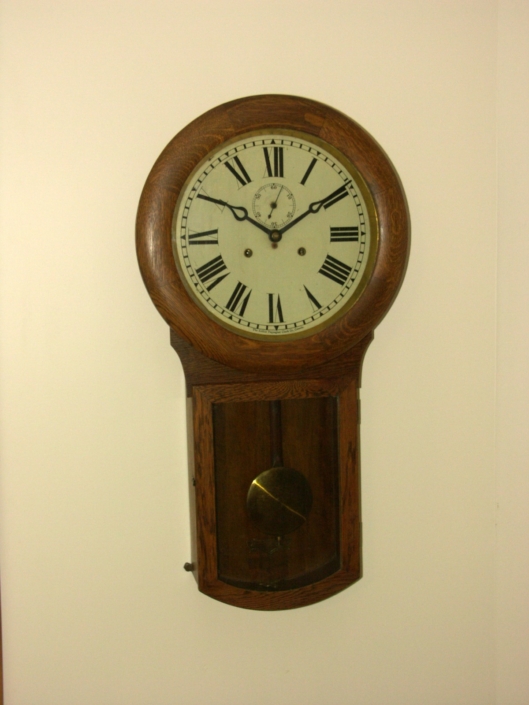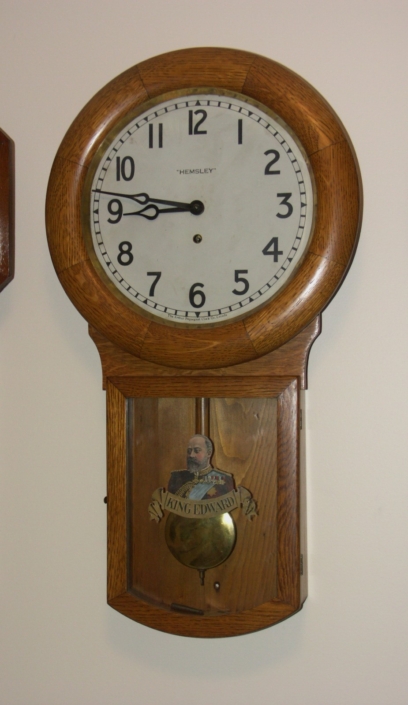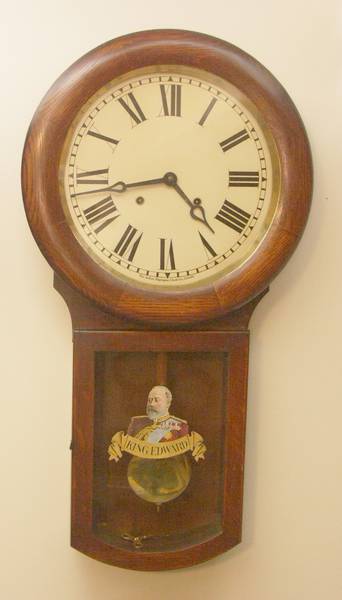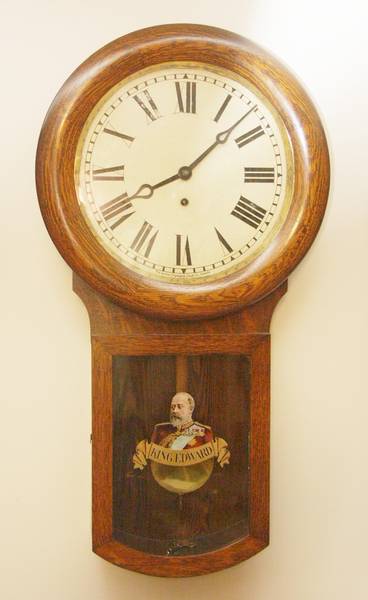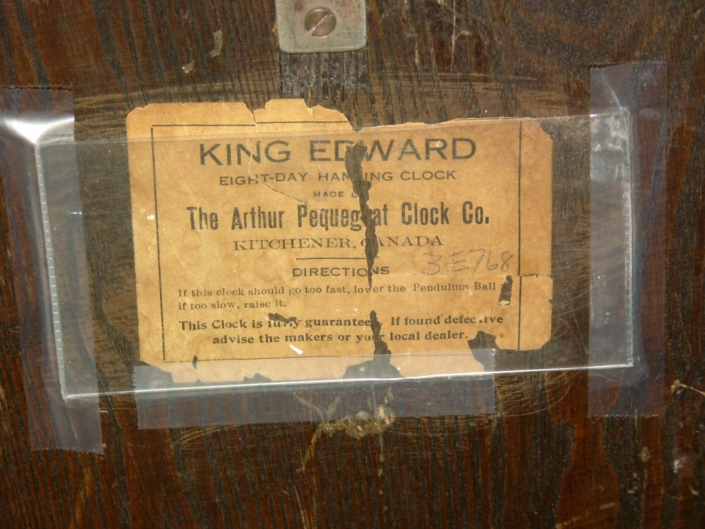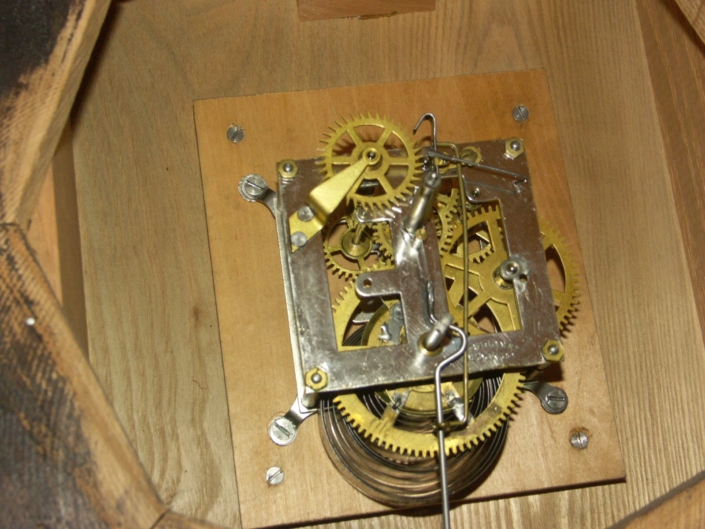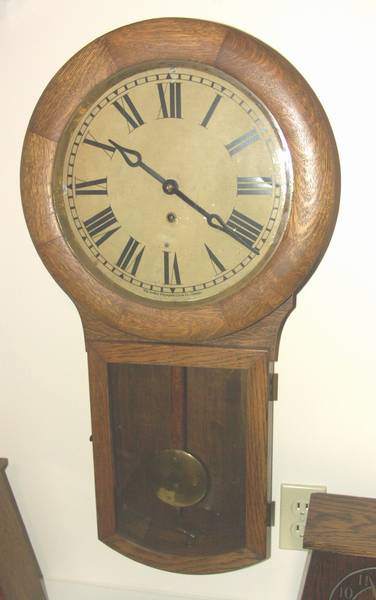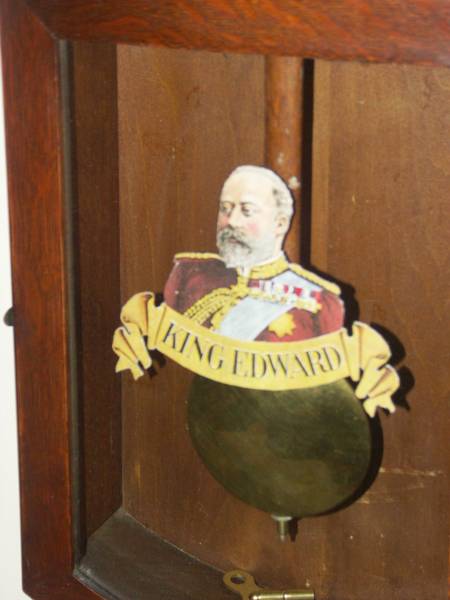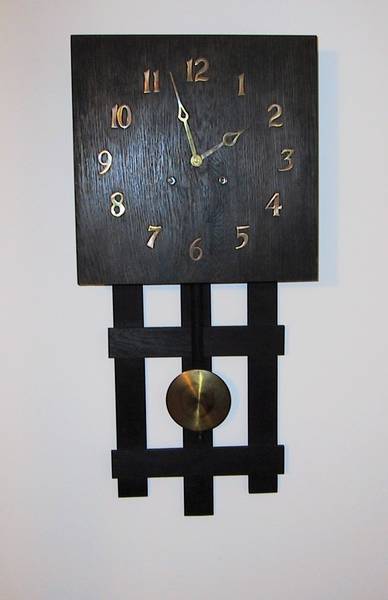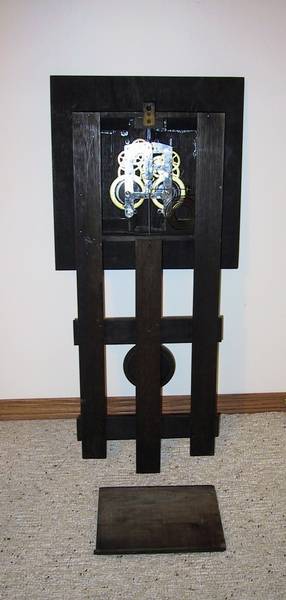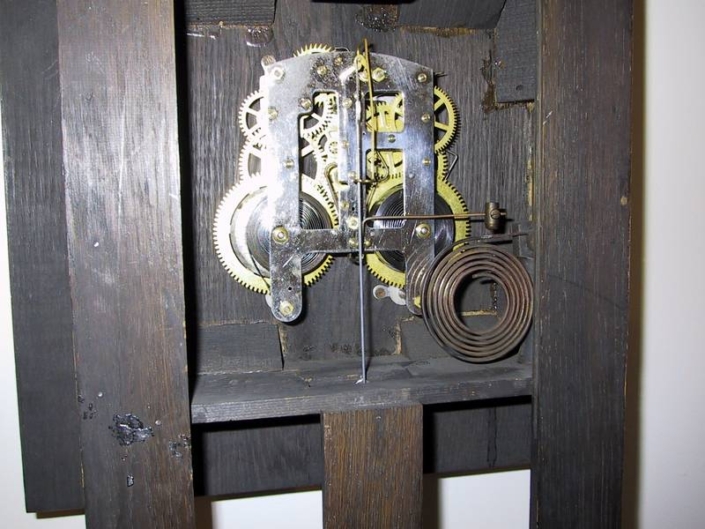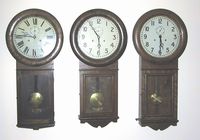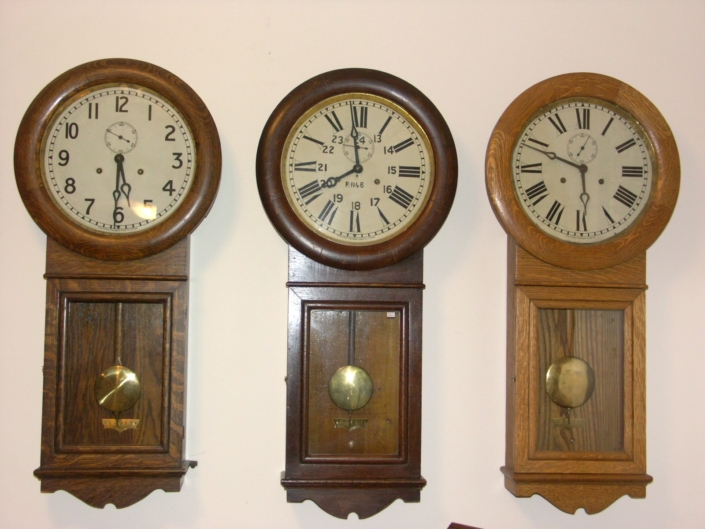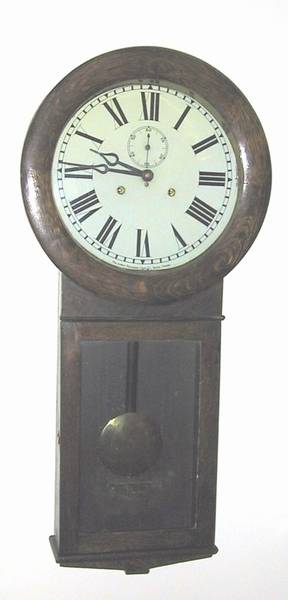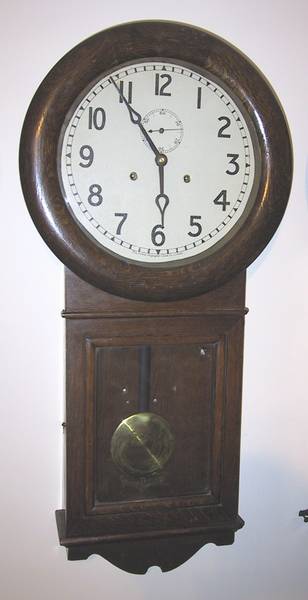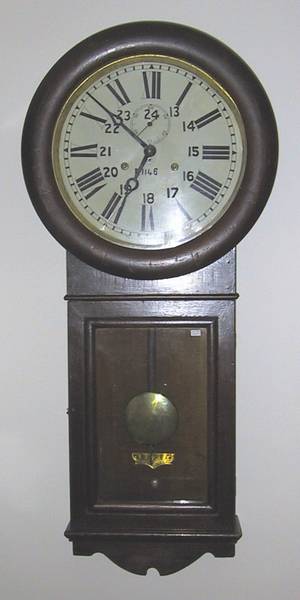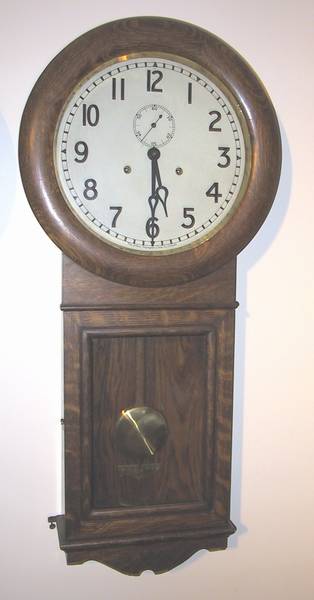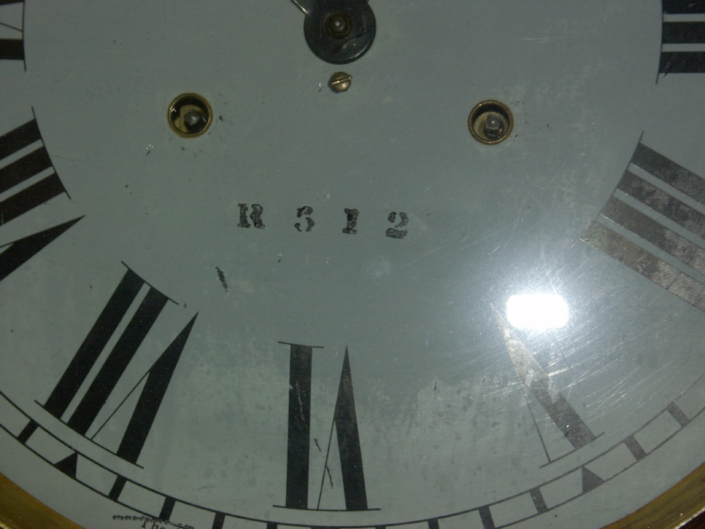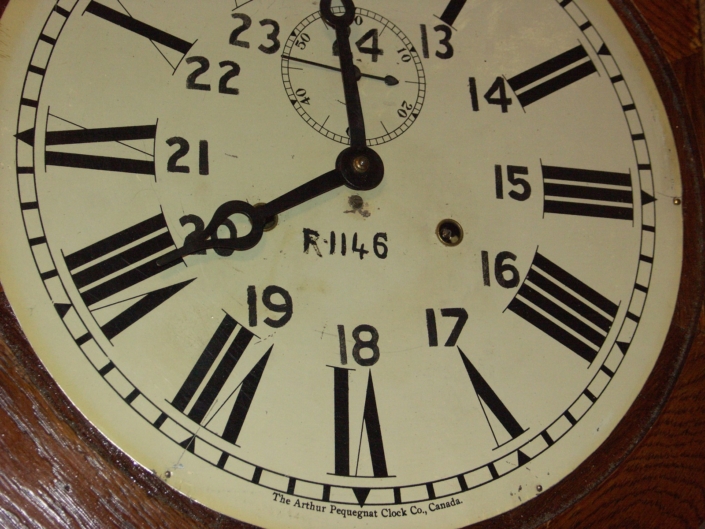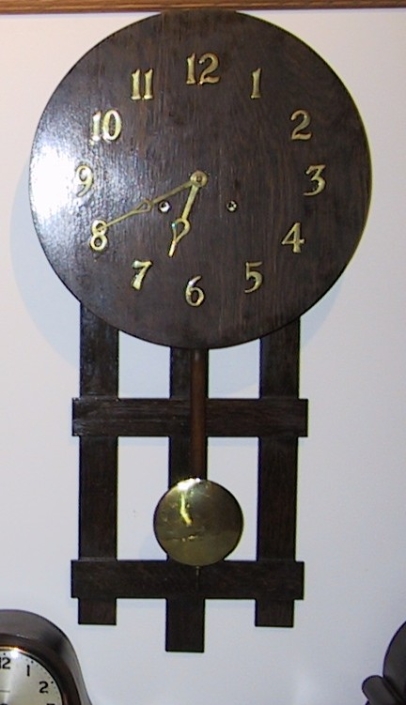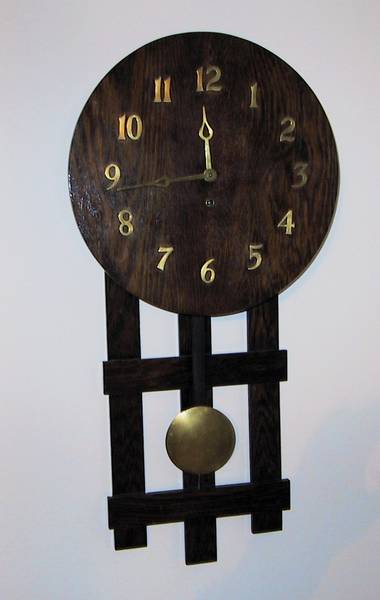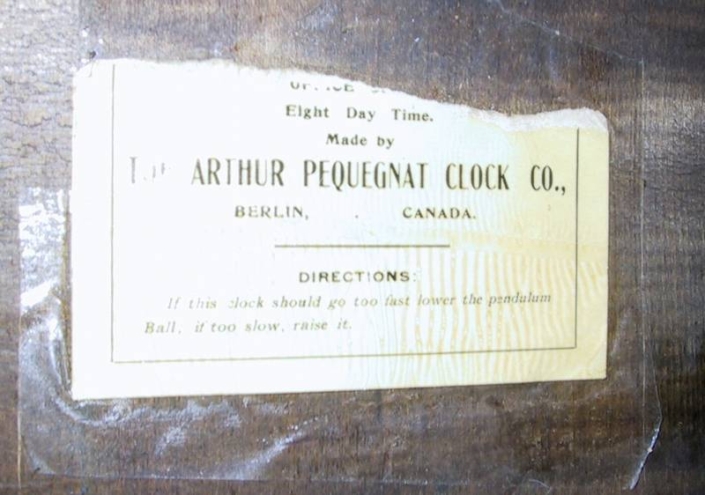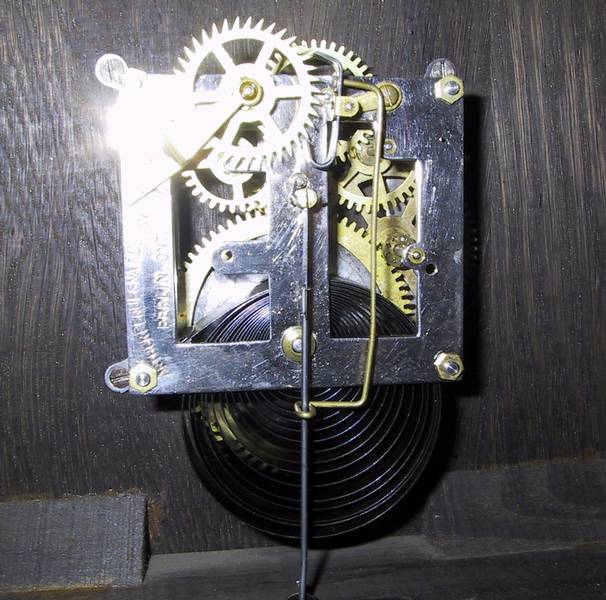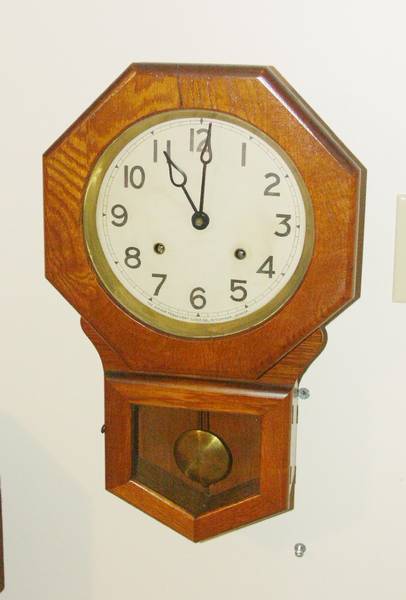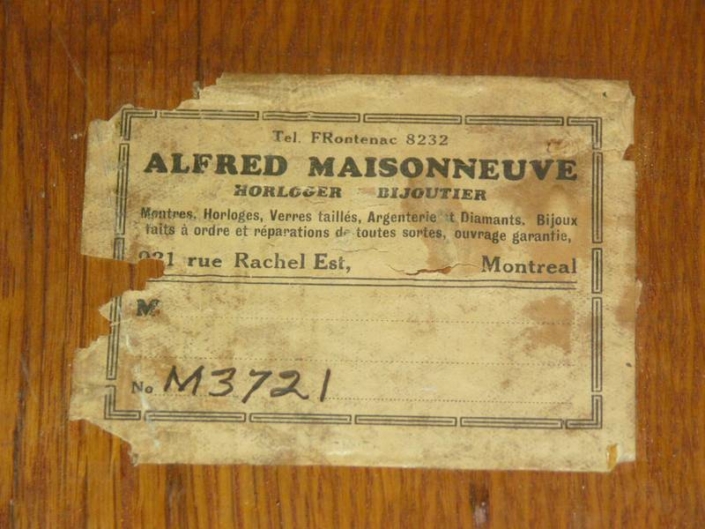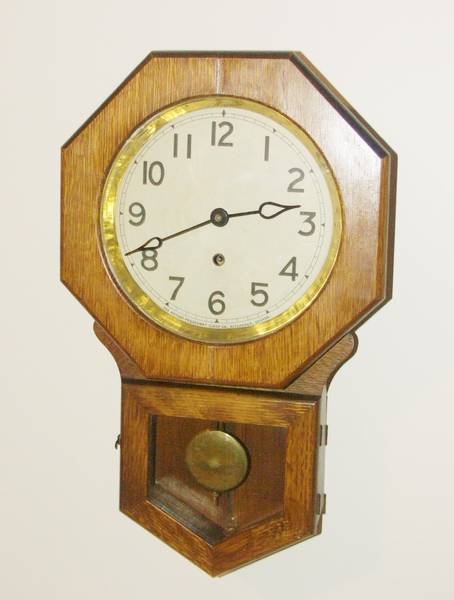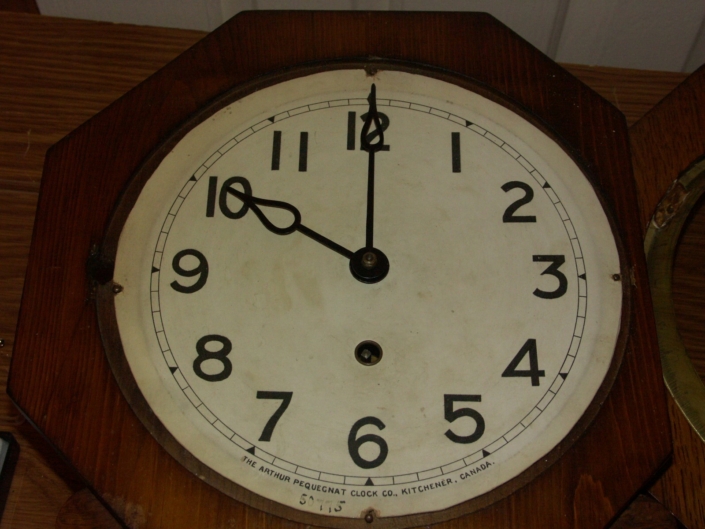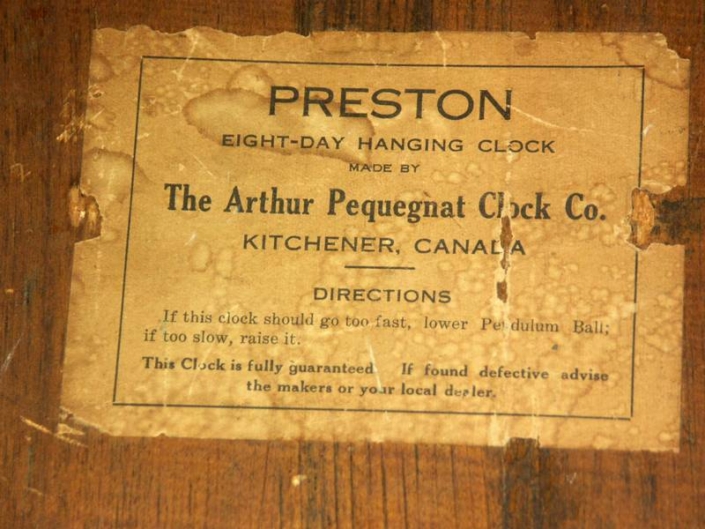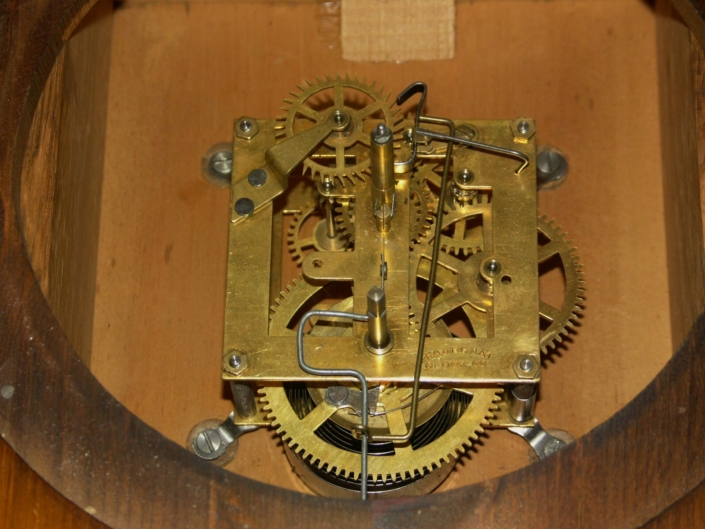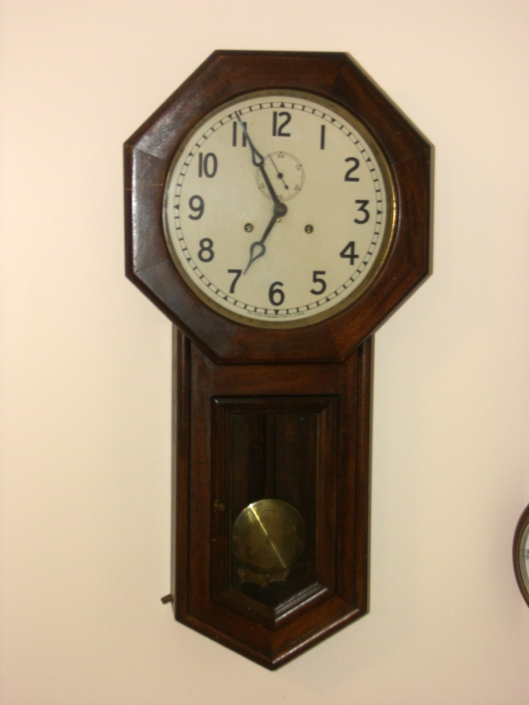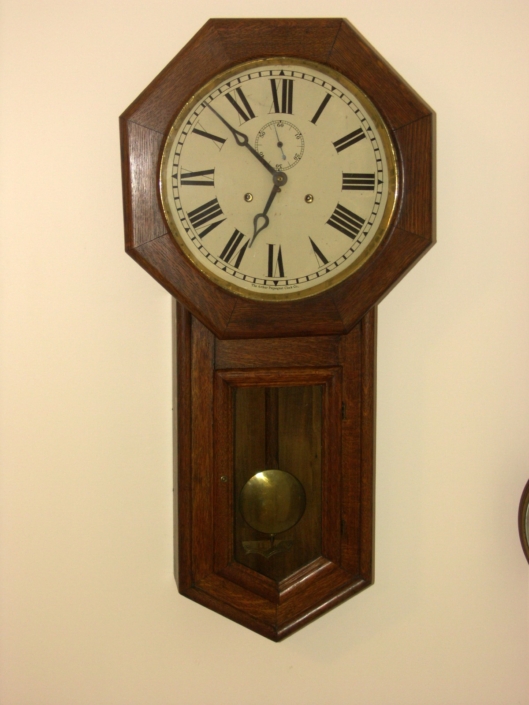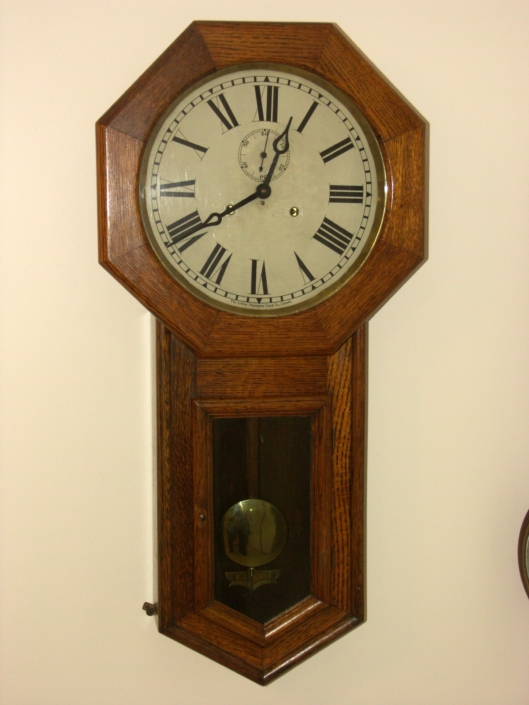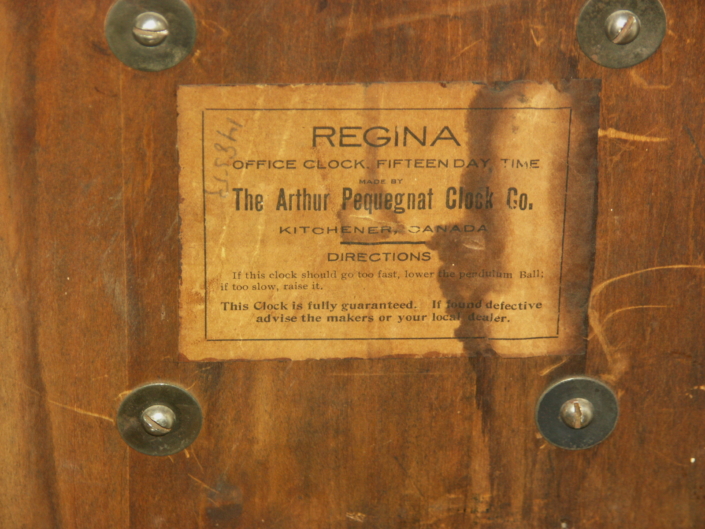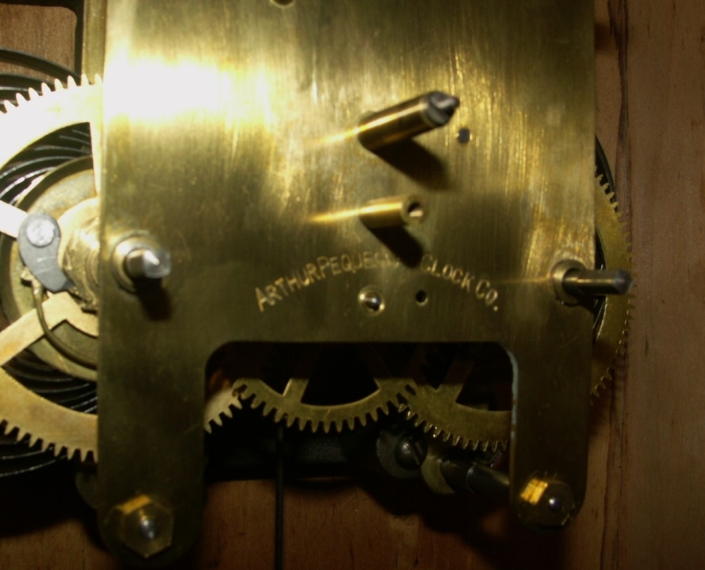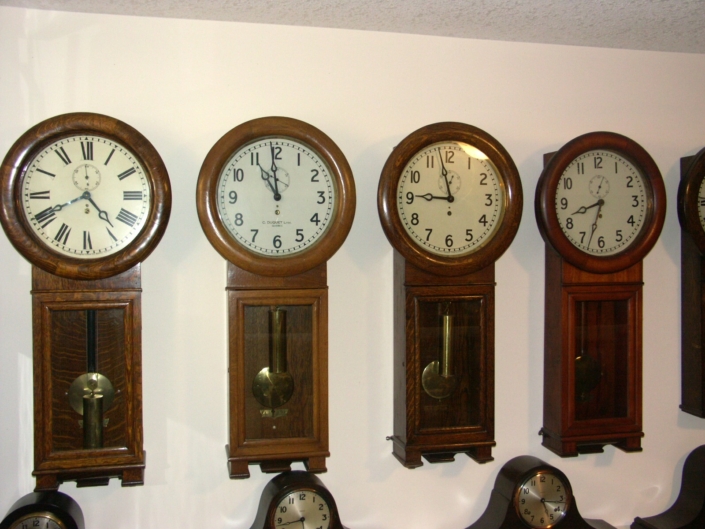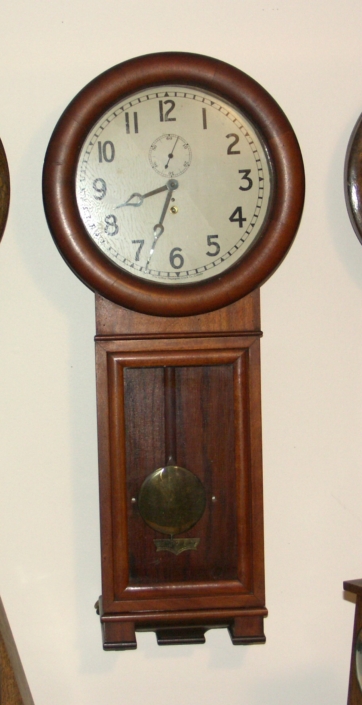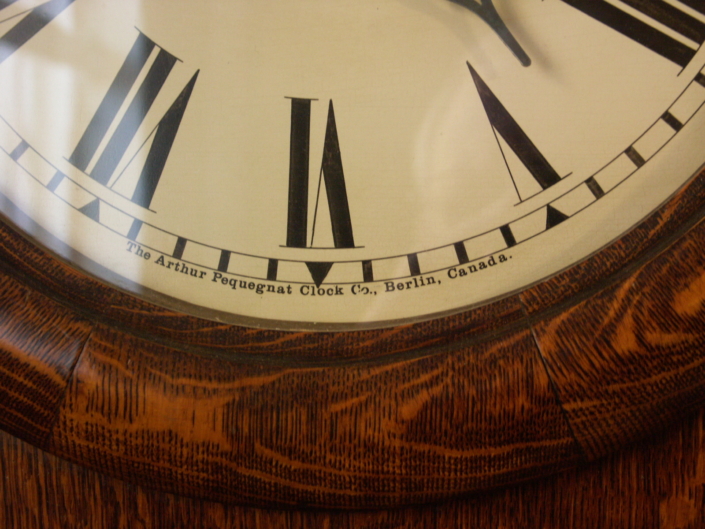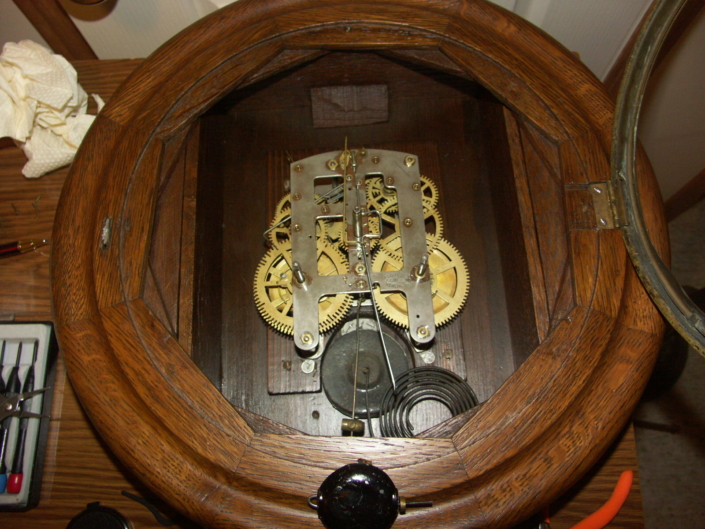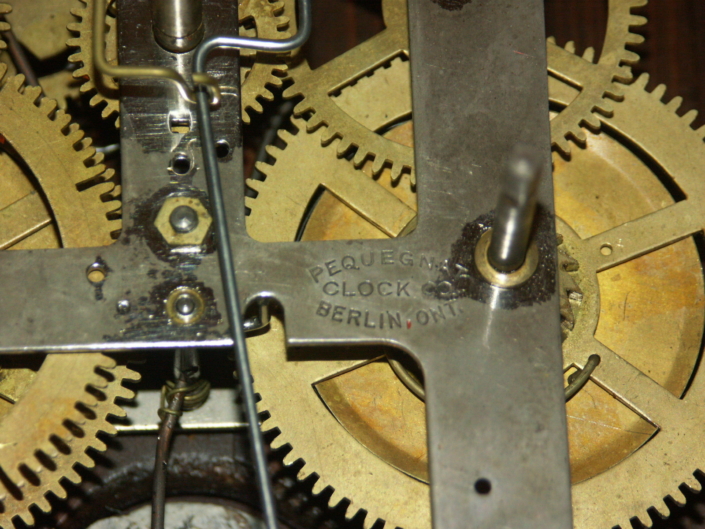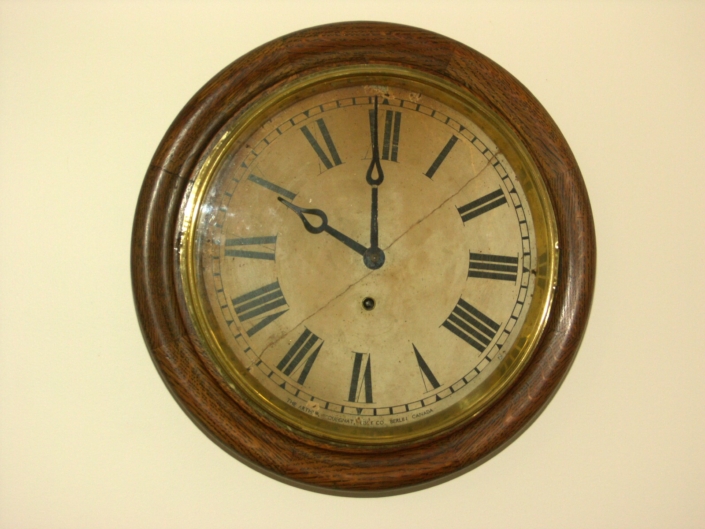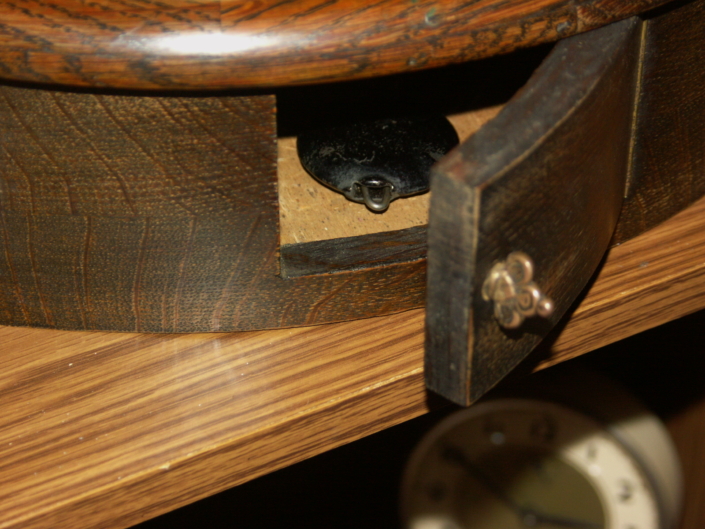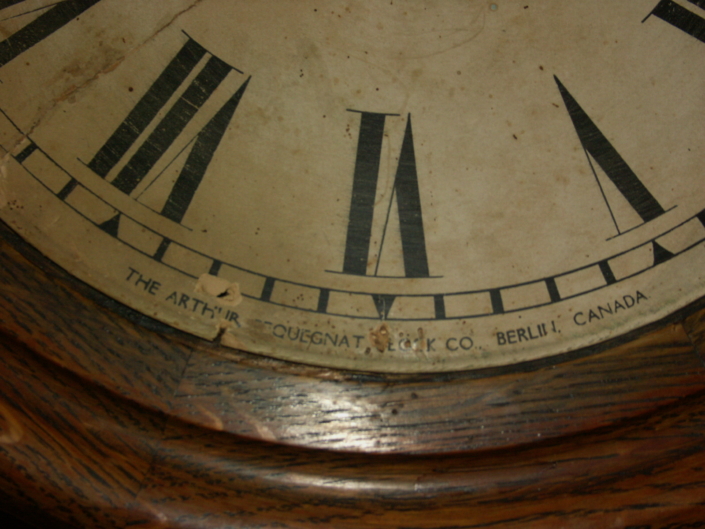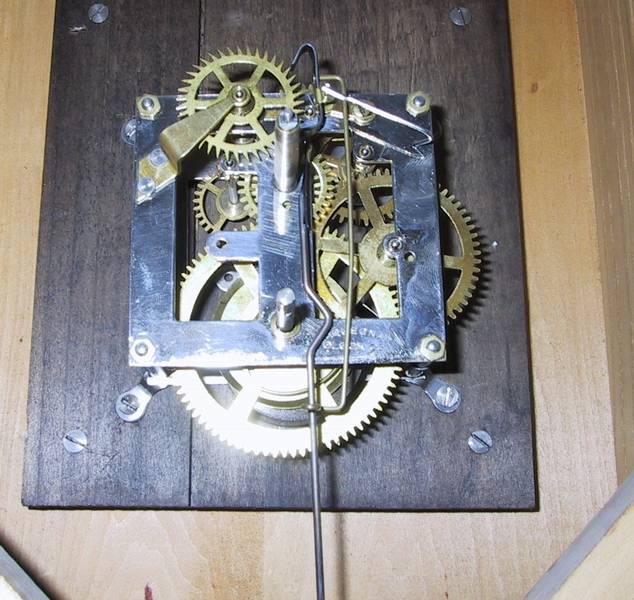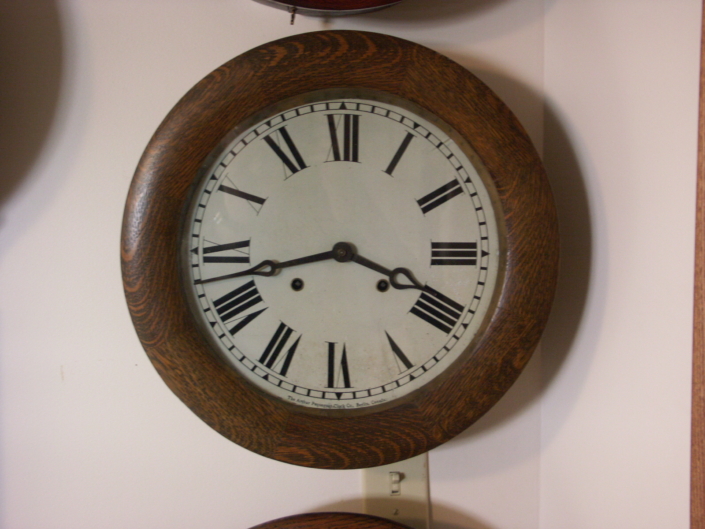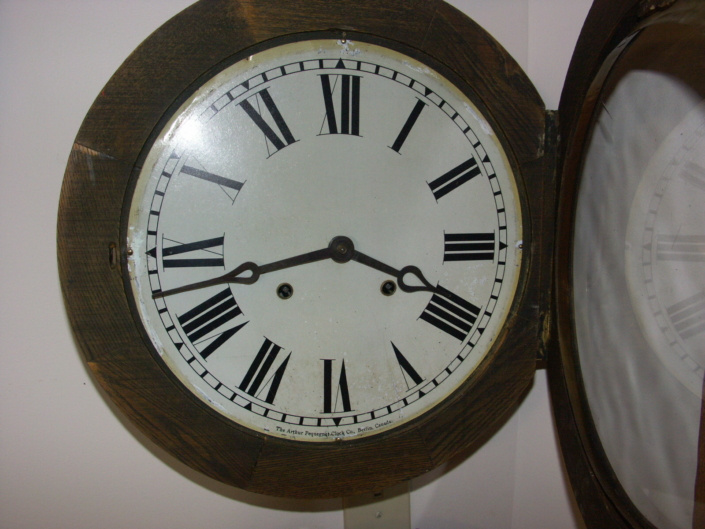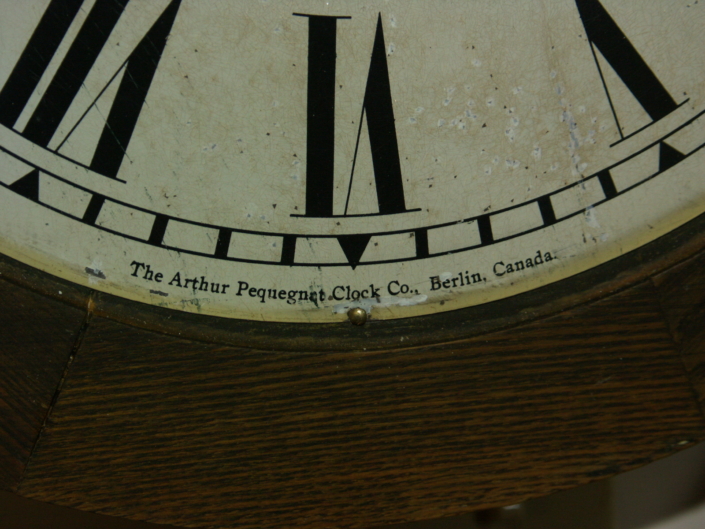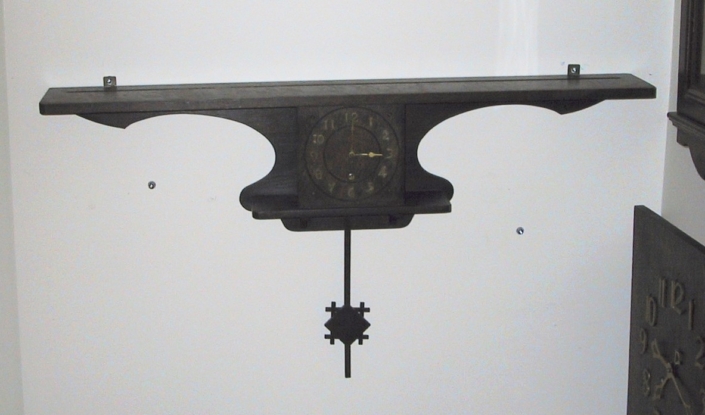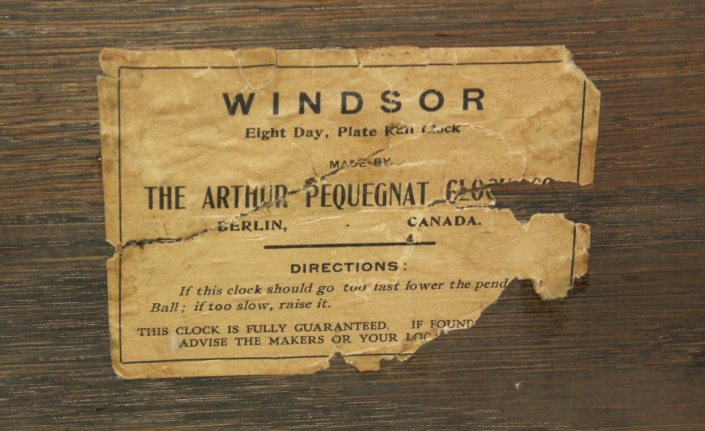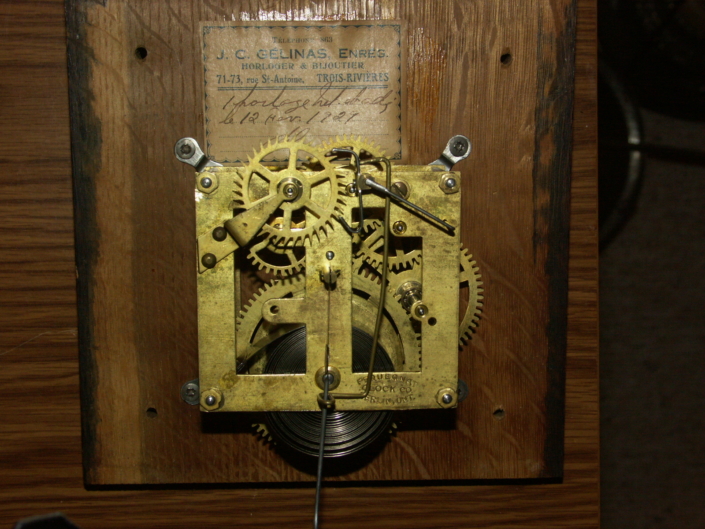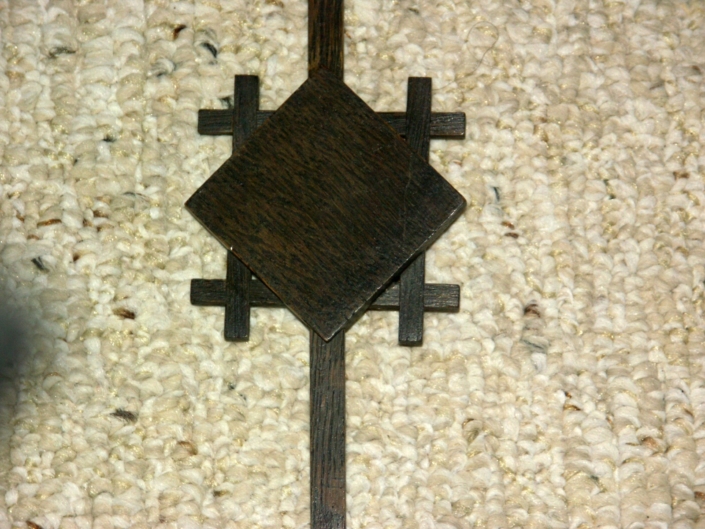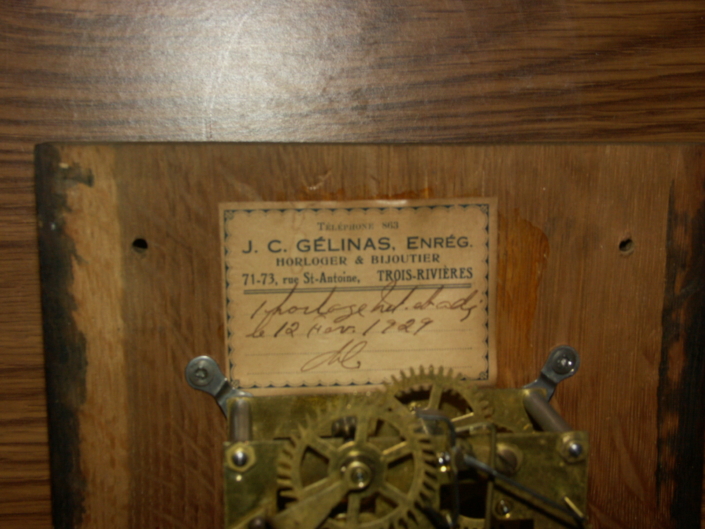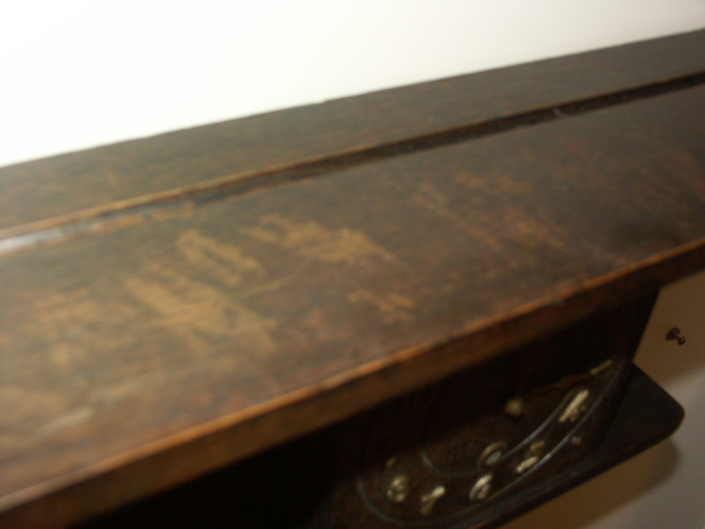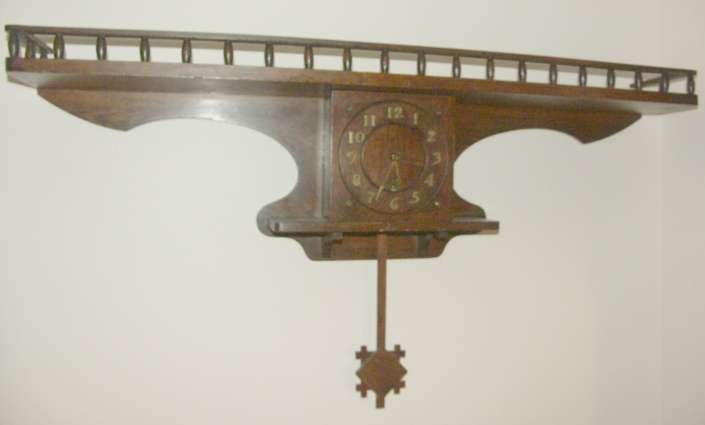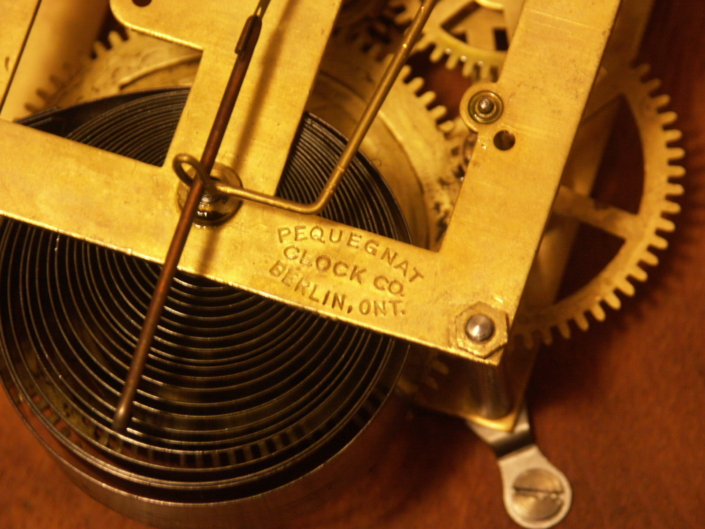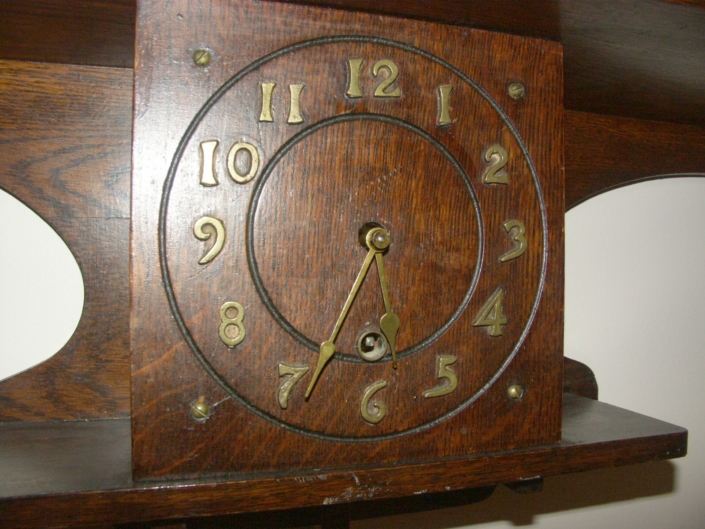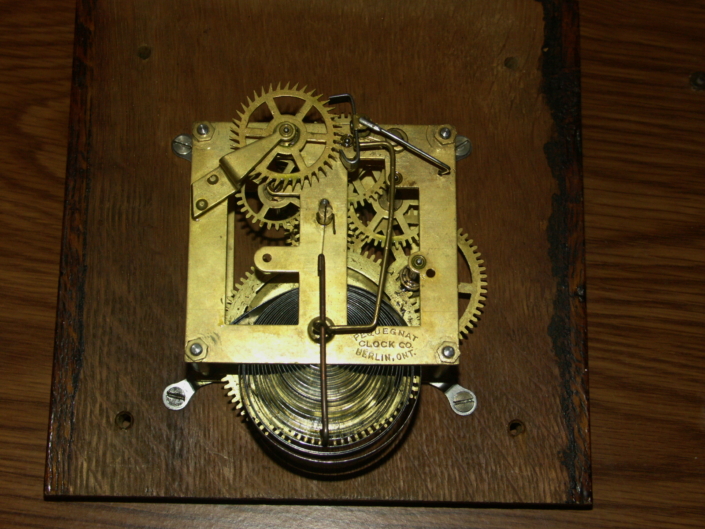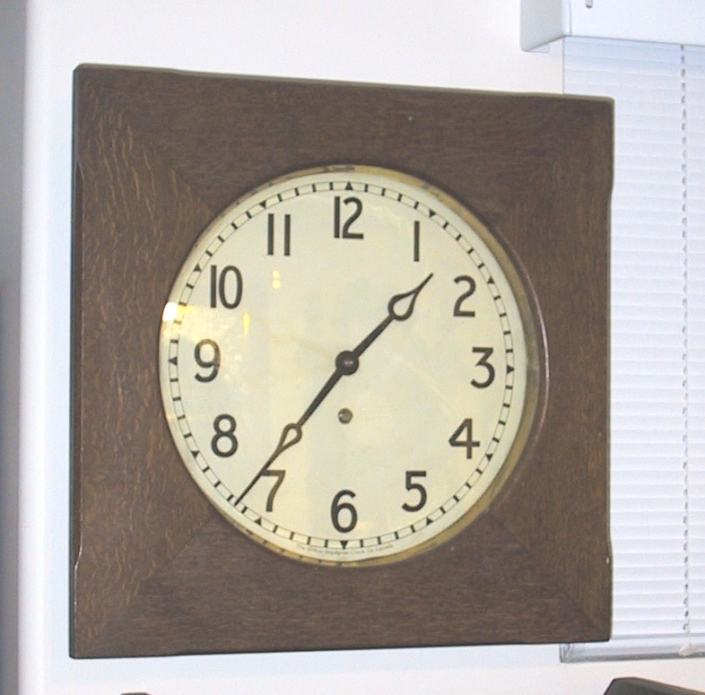Pequegnat Wall Clocks
Beaver – 1st Edition
These beautiful clocks are considered to be one of the most desirable of the Pequegnat wall clocks. As noted in “The Pequegnat Story” by Jane and Costas Varkaris: It is of interest to note that this model of clock honoured the beaver because, not only is the beaver Canada’s national animal, but the figure of the beaver forms a prominent part of the coat-of-arms of the City of Kitchener.
The Beaver was featured in the 1918 catalogue. It is interesting to note the different sizes of the pendulum bobs of these two clocks. The smaller bob is what you typically see in the somewhat smaller 2nd Issue Beaver introduced in the 1920 catalogue. Both pendulums look original to the clocks so one could suppose that the clock with the smaller bob may have been built closer to the 1920 period. The large bob clock is finished in Mahogany and the small bob clock is in Oak.
Both clocks are 8 day time and strike (on tuned rods) with a 5 inch porcelain dial. The clock measures 35 1/4 inches in height and 14 inches in width and is 7 iches deep.
This clock is not that hard to find for sale, however be prepared to spend some serious money.
Beaver – 2nd Edition
The little brother of the “1st edition Beaver” is harder find and commands big money when it comes up for sale. It first appeared in the series of Wall Clock Only catalogues issued from 1920 to 1925 and then appeared again in the standard issue1928 catalogue.
This mahogany finished clock stands 31 1/2 inches in height, 13 1/2 inches wide and is 6 1/2 inches deep. The clock was also available in an oak finsh. It has the same movement as the “1st Edition Beaver”, an 8 day movement with a double strike on tuned rods. As Pequegnat said in their advertising its “A Splendid Clock for Any Home”.
These clocks are considered rare are harder to find than their big brother.
Brandon – 1st Edition
Pequegnat’s earliest version of the classic schoolhouse clock. The clocks measure 26 1/2 inches in height by 16 1/2 inches in width. The 8 day movements came in: Time only, Time and Strike, Time and Calendar and Time Strike and Calendar. The lower glass normally came clear or with “Regulator” or “Standard Time” stenciled on it, however the Time/Strike model has an etched glass door that appears to be original to the clock.
The 1st Issue Brandon’s are easily identified from the 2nd Issues by the more ornate Trim around the bezel as well as the trim around the bottom doors. (see pictures).
These clocks are generally a little more difficult to find. I found the Time and Strike Model the most difficult of the four versions to come by.
Brandon – 2nd Edition
Both editions of the “Brandon” were offered for sale in the wall clock catalogues published from 1920 to 1925. The 2nd edition model was produced, with no changes in design, until the close of the factory in 1941.The “Brandon” 2nd Issue is just a continuation of a good thing. The only real difference between the two issue is the smooth trim (bezel and bottom door) on the 2nd issue rather that the more ornate trim on the 1st one. The clocks measure the same as the first issue, that’s 26 1/2 inches high, 16 1/2 inches wide and 4 1/4 inches deep.. Both clocks have a 12 inch metal dial. The 8 day movement comes in four variations that include: Time Only, Time and Strike, Time and Calendar and Time Strike and Calender. When fitted with the strike, it’s is on the traditional gong. A “Brandon” has been found with a factory installed chime rod rather than the gong, however this is a seldom seen variant (see Pequegnat Variants).
The Brandon’s glass could be plain or could have the words “Regulator” or Standard Time” stencilled on it.
These clocks are generally quite common except for the Time, Strike and Calendar model. I finally found one of them but it took a lot of looking.
Canadian Time
Probably one of the most popular of the Pequegnat clocks. Found in all the Pequegnat catalogues. The eight day movement is found as: Time Only, Time and Strike, and Time Strike Calendar. The “Canadian Time” measures 18 inches in width, 36 inches in height and is 5 inches deep. The words “Canadian Time” are stencilled in gold on the glass door.
The “Canadian Time” is generally considered fairly easy to find, however some versions are not. I’m still looking for variant with the 15 day movement. They say there is a “Canadian Time” with painted glass around the bezel, rather than wood, I’d sure like to get one of those too.
The Pequegnat motto for the clock was “The best office clock in the market for the price” and it probably was.
Daisy
The “Daisy” was only offered in the wall clock catalogue from 1920 to 1925. This diminutive clock is approximately 16 1/4 inches tall and 8 1/14 inches wide. They have a 8 day time only movement with a decal dial. These were packed 2 to a carton or in sets of 6 assorted.
There is also a number of variants around as, typical of the Pequegnat clocks, from time to time backboards and dials were interchanged to create clocks with rounded tops and scalloped bottoms or vice-versa. There has also been seen a “Daisy” with raised Brass Numbers instead of the traditional decal dial.
These clocks are rare and harder to find.
Ideal
The “Ideal” model was introduced in the Wall Clock Only Catalogues from 1920 to 1925 and also appeared in the last catalogue published in 1928. The clocks were fitted with 8 day movements that were either Time Only or Time and Strike. The strike normally being on the usual gong on the half and and on the hour. (an “Ideal” with a single chime rod has also been seen). The clocks measured 24 inches in height with a width of 11 inches and a depth of 4 3/8 inches.
The eight inch clock dial is actually made out of cardboard with the Maple Leafs stencilled in the corners.
This is considered to be one of the easier Pequegnat Wall Clocks to find.
King Edward – 1st Edition
This popular clock was introduced in the 1904 Pequegnat Catalogue supplement. It appeared in every catalogue after that: to include the 1913, 1918, 1920-25 Wall catalogue and the final catalogue produced in 1928.
The clock was named after King Edward VII, the King of England from 1901 until 1910. The decal bears his likeness. The first issue “King Edward” the dial is covered by glass in a brass “sash”, unlike the 2nd Issue of these clocks that have the wooden from hinged to the front of the clock, holding the glass.
These clocks have an 8 day movement that can be Time only or Time and Strike. I don’t believe the “1st Edition King Edwards” have been seen with the calendar feature that has been recorded on the 2nd Edition of this clock.
The Time only model measures 30 inches in height and 16 inches in width, however the Time / Strike model is an inch shorter at 29 inches. The drop on the 1st Edition is 12 1/2 inches where as the 2nd Edition drop is 13 1/2 inches.
These beautiful clocks show up from time to time however they are considered rare and hard to find.
King Edward – 2nd Edition
This popular clock was introduced in the 1904 Pequegnat Catalogue supplement. It appeared in every catalogue after that: to include the 1913, 1918, 1920-25 Wall catalogue and the final catalogue produced in 1928.
The clock was named after King Edward VII, the King of England from 1901 until 1910. The decal bears his likeness. Unlike the first issue “King Edward” where the dial was covered by glass in a brass “sash” the 2nd Issue of these clocks had a wooden frame hinged to the front of the clock, holding the glass.
The catalogued clocks have an 8 day movement that can be: Time only, Time / Strike, Time /Strike / Calendar or Time / Calendar. Also pictured is a “variant “King Edward” with the “Moncton” 15 day Movement.
The clocks measure 30 inches in height, 16 inches in width and are 5 inches deep . These beautiful clocks show up from time to time however the models with the calendars are really rare and hard to find.
The clock below with the plain glass has a replacement decal that is pictured below. Mans best friend “Chelsea” broke the glass in a burst of enthusiasm a few years ago!
Kingston
The Arts and Crafts style “Kingston” is very similar to it’s brother the “Ottawa”. The major difference being the “Ottawa” has a round Dial and the “Kingston” has a square dial.
The “Kingston” was first featured in the 1904 catalogue #1 supplement, and then the 1913 and the 1928 catalogues. The Weathered Oak case measures 32 inches in height and is 15 inches wide and is 4 1/4 inches deep.
The clock came in two models, one being Time Only and the other Time With Strike on the traditional gong.. Both were eight day Movements. The clocks have an 11 1/2 chapter ring with brass numbers.
Although offered for sale in fewer catalogues, the “Kingston” is an easier clock to find than the “Ottawa”.
Moncton (2 Editions)
Only two Pequegnat models were fitted with 15 day movements that was the “Moncton” and the “Regina”. It was a double spring movement with a Graham dead beat escapement.
I love their advertising for this clock that stated: Specially adapted for Railroad Stations, Public Buildings and Offices, where accurate time is required.
The “Moncton” came in two basic styles: The 1st Issue which was 33 1/4 inches high by 15 1/2 inches wide with the triangular bottom. The 2nd issue of the clock has a height of 33 1/4 inches and a width of 16 inches with a rounded bottom. The 2nd issue clock is also found with cases that measure 35 1/4 inches in height.
The “Moncton” model was one of the clocks used by the Canadian National Railways (CNR). The CNR clocks have a three or four digit number prefixed by the letter “R” stenciled on to the dial. CNR also used other clock models such as the Seth Thomas “World” model for their station clocks. These clocks were also marked with the Rxxx stencil.
The “Moncton” was first featured in the 1913 catalogue and the again in the 1918, 1920 to 1925 Wall Clock catalogues and the Pequegnat’s final catalogue put out in 1928.
You see “Monctons” up for sale from time to time, but they are getting harder and harder to find. There are six “Monctons” in my collection.
Ottawa
The arts and crafts style “Ottawa” is very similar to it’s brother the “Kingston”. The major difference being the “Ottawa” has a round Dial and the “Kingston” has a square dial.
The “Ottawa” was first featured in the 1904 catalogue #1 supplement, and then the 1913, 1918, and the1928 catalogues as well as the Wall Clock Only Catalogues from1920 to 1925. The “Weathered Oak” clock measures 32 inches in height and is 15 inches wide and is 4 1/4 inches deep.
The clock came in two models, one being Time Only and the other Time With Strike on the traditional gong.. Both were eight day Movements. The clocks have an 11 1/2 chapter ring with brass numbers.
The “Ottawa” was in production for years, however is still a difficult clock to find.
Preston
The “Preston” Wall Clock’s were only seen in the Pequegnat Wall Clock catalogues of 1920 to 1925. This little cousin of the 2nd Issue “Brandon” came with an 8 day movement which would be either Time Only or Time and Strike (on the Cathedral Gong).
These “Golden Oak” cased clocks measure 19 1/2 inches high by 12 inches wide and are 4 1/2 inches deep. They have an eight inch cardboard dial.
These good looking diminutive school clocks are still fairly easy to find.
Regina
The “Regina” is one of my favourite clocks and I’m pleased to have three of them in my collection. It was only offered for sale in the 1918 and 1928 catalogues. It has the classic school clock look with Octagon Top with the Long Drop so you can see the pendulum swing back and forth. The clock measures 32 1/2 inches in height, by 16 inches in width and is 5 inches deep. It has a 12 inch metal dial.
To power this formidable clock, it has the 15 day double spring movement, hung on an iron bracket with the Graham Dead-beat Escapement. This is the same movement that was used in the “Moncton”.
Pequegnat stated in their advertising: “A mate to our “Moncton”. Two clocks were are justly proud of. As an accurate timekeeper this clock is not excelled”. The were obviously very proud of this model!
A rare and extremely hard clock to find.
Regulator # 1
The Regulator #1 is no doubt the best timekeeper made by Pequegnat. The company said in it’s advertising: “A Handsome Clock, fitted with a Movement which is unexcelled”, Beautiful Finish on both Movement and Case”. They also stated that this clock is “The Finest Office Clock Made”! As far as Pequegnat clocks go there is no doubt that these statements are true.
It had an eight day movement with brass weights hung on an iron bracket. They were time only, at 80 beats per minute. They had a Graham Dead-beat Escapement, Lantern Pinions and Maintaining Power.
The clock measures 36 inches in height and is 15 3/4 inches wide. It has a 12 inch dial. The clock was available in either mahogany or golden oak.
The clock was first offered for sale in the 1904 Catalogue supplement and was offered in every other catalogue there after.
I wouldn’t say this clock is rare but I would say it’s highly sought after. I am pleased to have four of them in my collection.
Toronto – 1st Edition (T, T/S)
The popular Gallery clock the “Toronto” was in the Pequegnat Catalogues published in 1904, 1913, 1918, and 1928 as well as the 1920 to 1925 Wall Clock Catalogues.
The clock came in two very distinct styles with the major difference being the dial of the “Toronto 1st Edition” is covered by a brass sash unlike the 2nd Edition clock which has a wooden frame hinged to the front of the clock to hold in the glass.
The Pequegnat Catalogues only make mention of a Time Only Model for the “Toronto 1st Edition”, however I have a Time / Strike version as well. I have included the Time / Strike version in my list of variant clocks as well.
The Time Only model has an eight day movement. The Golden Oak finished clock measures 16 1/4 inches in diameter, and is 5 inches deep and the 11 inch dial is made of cardboard. (Heavy cardboard dials were used on some of the very early Pequegnat clocks, with larger dials, but were replaced with the metal dial pans early on as the cardboard dials tended to discolour and damage easily.) In later years the paper dials were reintroduced on the models of the “Ideal” and the “Preston”.
The uncatalogued Time / Strike model clock was purchased off Ebay as a complete restoration job. First let me say the all of the key parts seemed to be original to the clock. To get the clock as you see it here the following was done: The clocks dial was redone by a dial restorer in the USA, the case restored by a cabinet maker in Edmonton and the movement was restored and all the components put together by Ken Wilkie in Saskatoon. An international effort however in the end it was worth the effort. The clock is certainly an interesting and unusual example.
The clock has an eight day time and strike movement in a golden oak case. The clock also measures 16 1/4 inches in diameter, is 5 inches deep and has an 11 inch dial. This time however the dial is painted on the original tin dial pan not heavy the cardboard as seen on the Time Only model.
The “Toronto 1st Edition” is a very hard to find clock.
Toronto – 2nd Edition (T, T/S)
The “Toronto” was featured in all Pequegnat catalogues 1904, 1913, 1918 and 1928 as well as the wall catalogues from 1920 to 1925. Both models are the later version of the “Toronto” even though the dials are marked Berlin. They both measures 16 inches in diameter and are 5 1/4 inches deep.
Earlier versions (1st Edition) had the outside 10 1/2 inch brass bezel rather that the wood bezel.
Both Clocks have eight day movements. This beautiful little clock in the time only version gallery is still rather easy to find, however the time and strike version is very rare and consequently difficult to find.
Windsor
The “Woodstock” and the “Windsor” are identical in all ways, except that the “Woodstock” has a 1 1/2 inch tall railing around the top of the clock. They are designed and were sold as “shelf clocks” To that end both have a grove running across the length of the top of the clock. Decorative plates etc. could be put into the grove and it would help secure them.
Both models appeared in the 1913 and 1918 catalogues. The clocks measure 39 inches in width, the cases are 10 1/4 inches tall and are 5 3/4 inches deep. These clocks have the wooden “squared” designed pendulum bob that is unique to these two models. They have the mission dials with cast-brass numbers. The number 3 and the number 5 have the long tails typical of the Pequegnat mission dials. Both have 8 day time only movements.
These clocks are rare and difficult to find!
Woodstock
The “Woodstock” and the “Windsor” are identical in all ways, except that the “Woodstock” has a 1 1/2 inch tall railing around the top of the clock. They are designed and were sold as “shelf clocks” To that end both have a grove running across the length of the top of the clock. Decorative plates etc. could be put into the grove and it would help secure them.
Both models appeared in the 1913 and 1918 catalogues. The clocks measure 39 inches in width, the cases are 10 1/4 inches tall and are 5 3/4 inches deep. These clocks have the wooden “squared” designed pendulum bob that is unique to these two models. They have the mission dials with cast-brass numbers. The number 3 and the number 5 have the long tails typical of the Pequegnat mission dials. Both have 8 day time only movements.
These clocks are rare and difficult to find!
York
The “York” is surely one of the plainest Pequegnat clocks ever made, however it is one of the most desirable for collectors. It was only advertised in Catalogue Number 5, featuring only wall clocks, and was distributed from 1920 until 1925.
The clock measures 16 1/2 inches square with a 12 inch dial. it has an 8 day movement that is Time only. It was also available with a Time and Strike movement.
I really believe that this clock was so ugly it didn’t sell well and consequently it is rare and extremely difficult to find. I’m still looking for a Time and Strike model.

